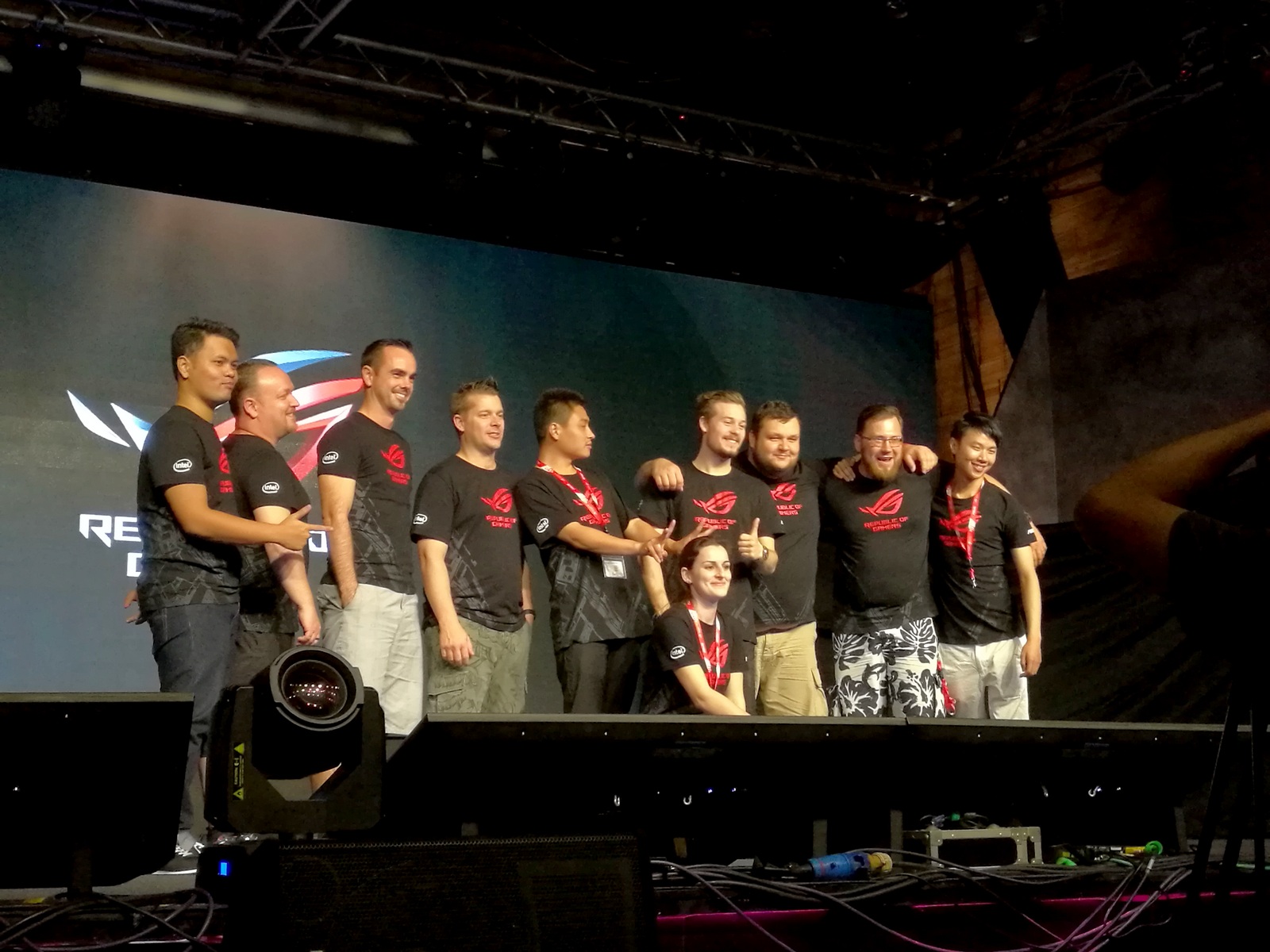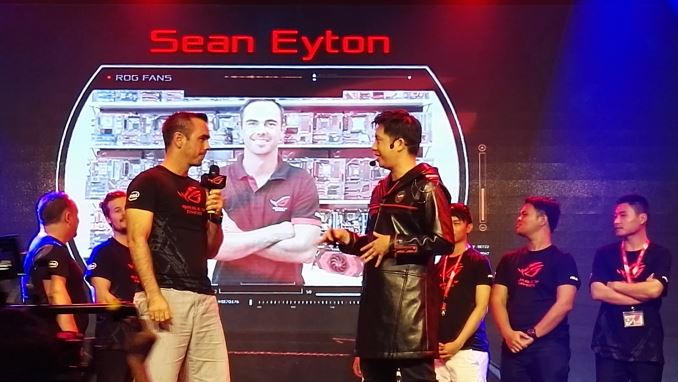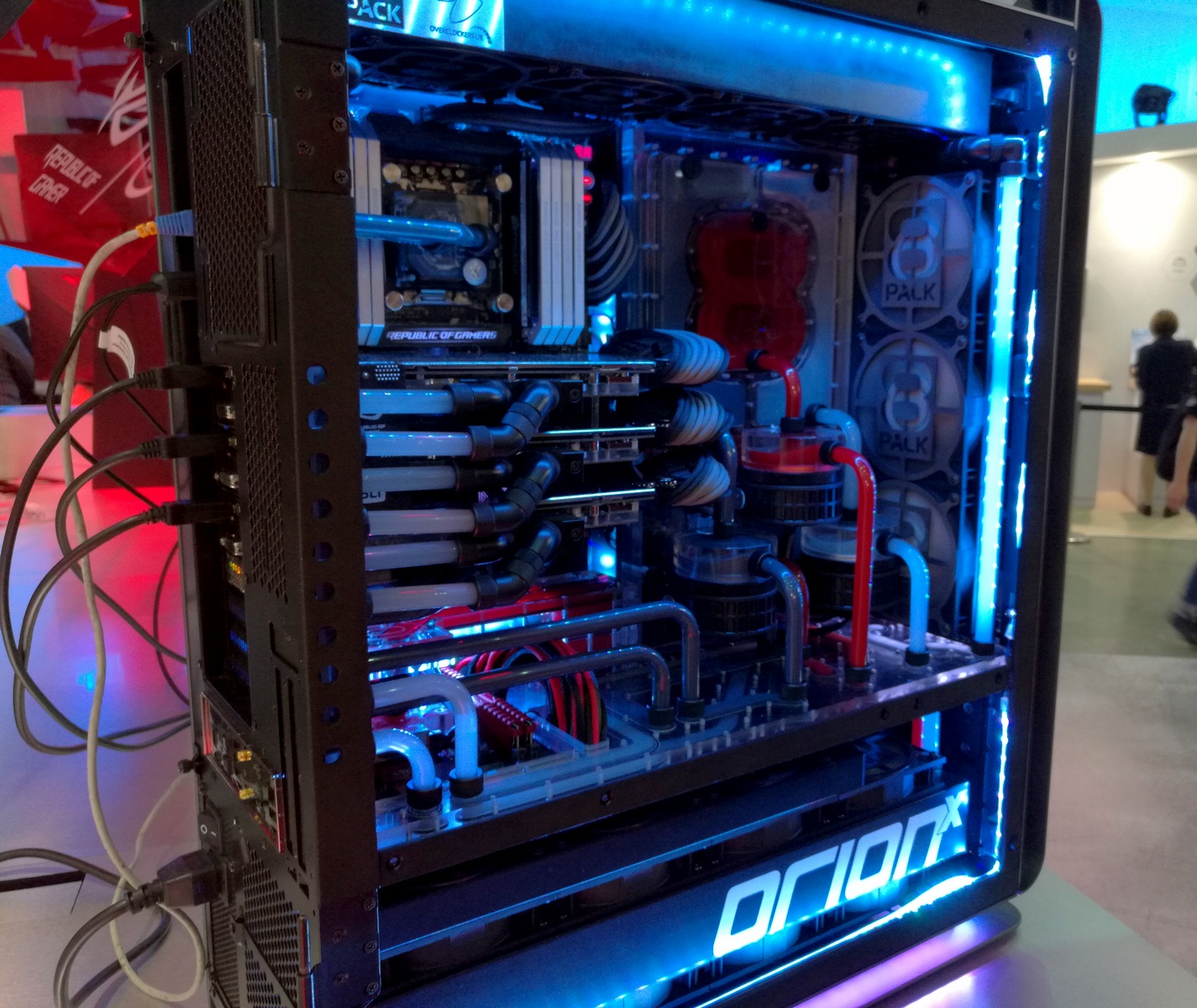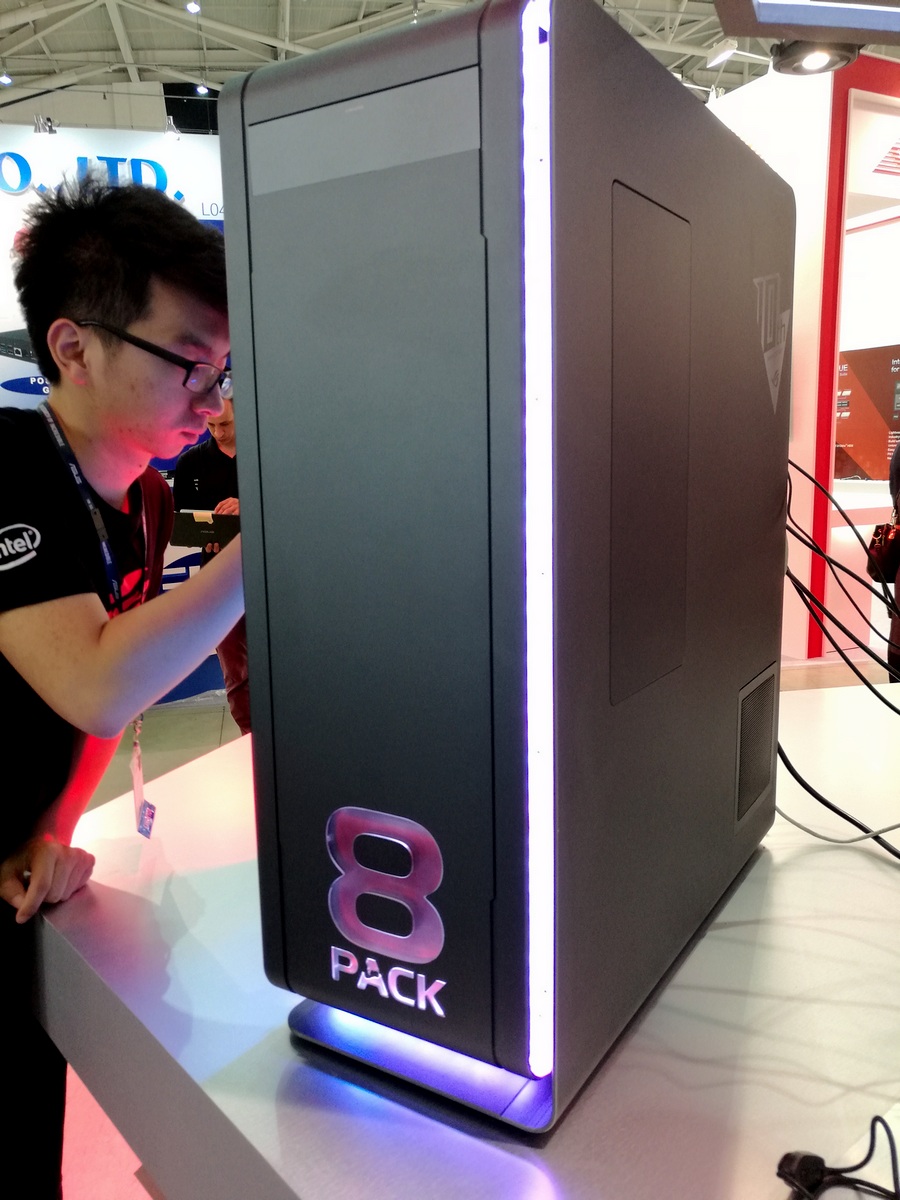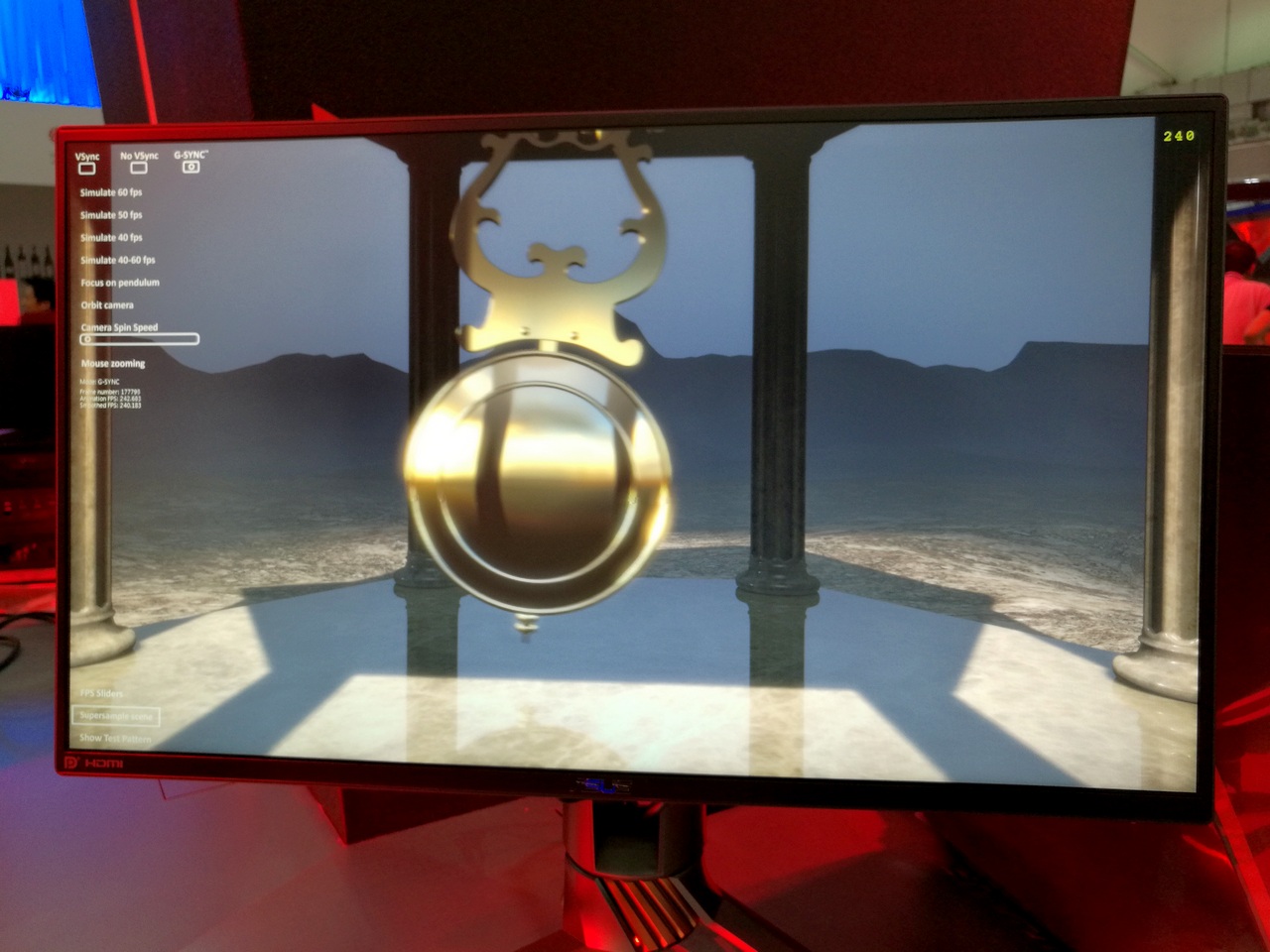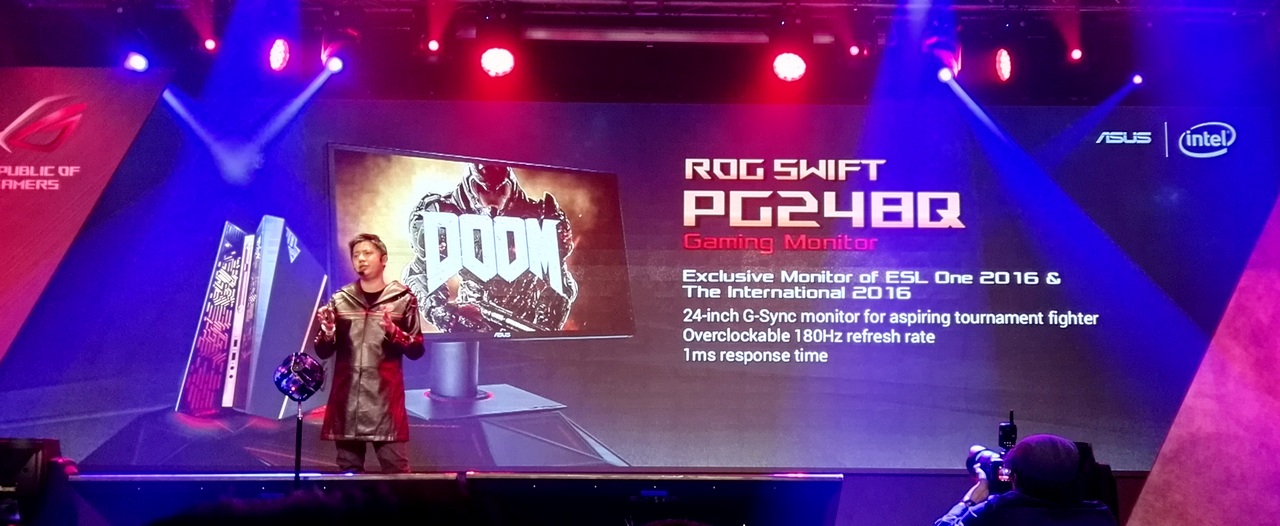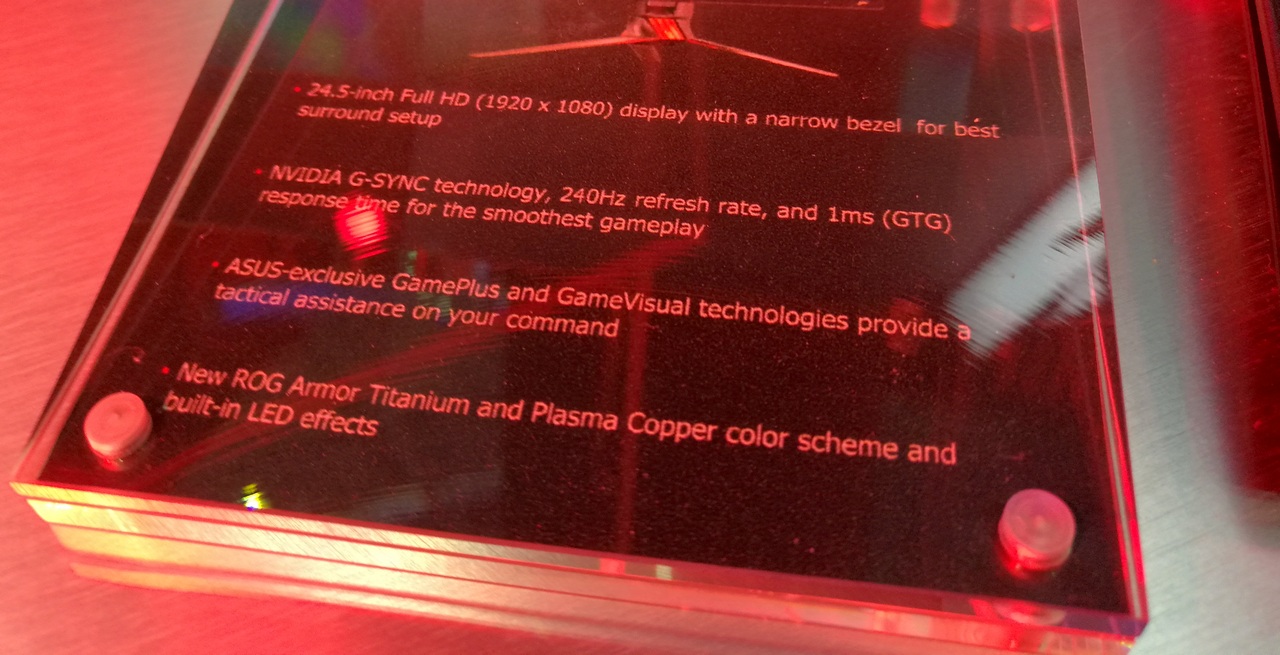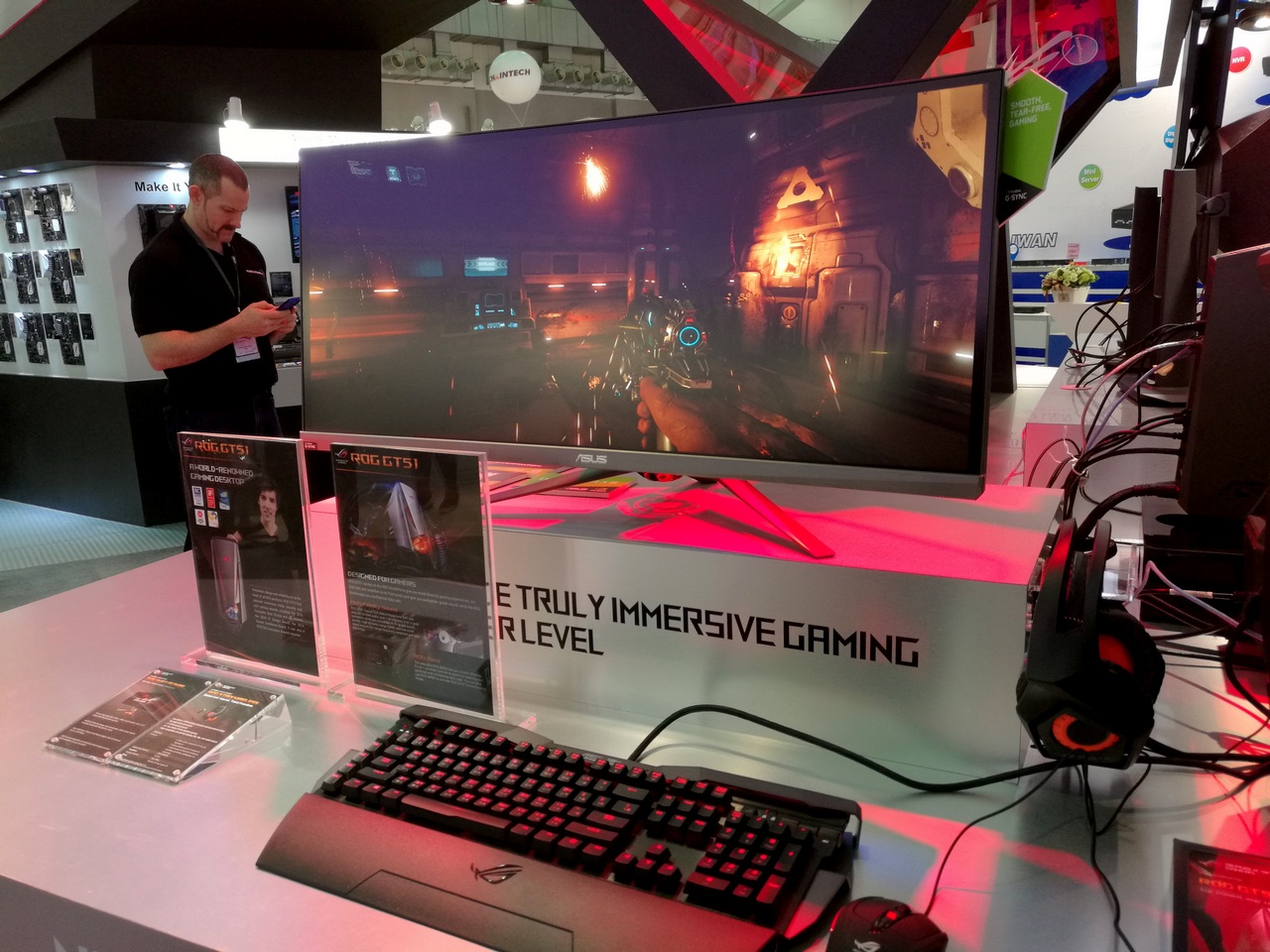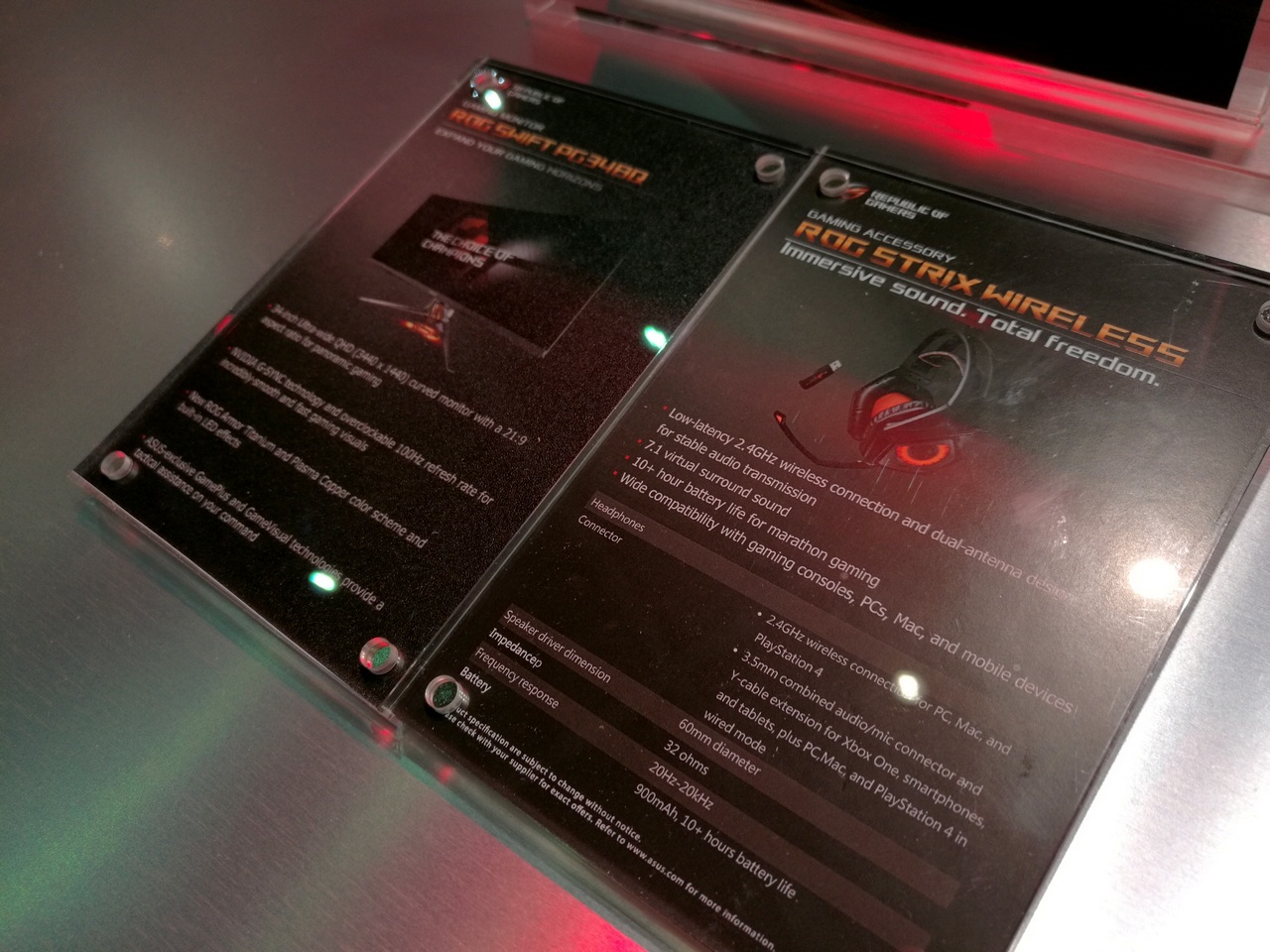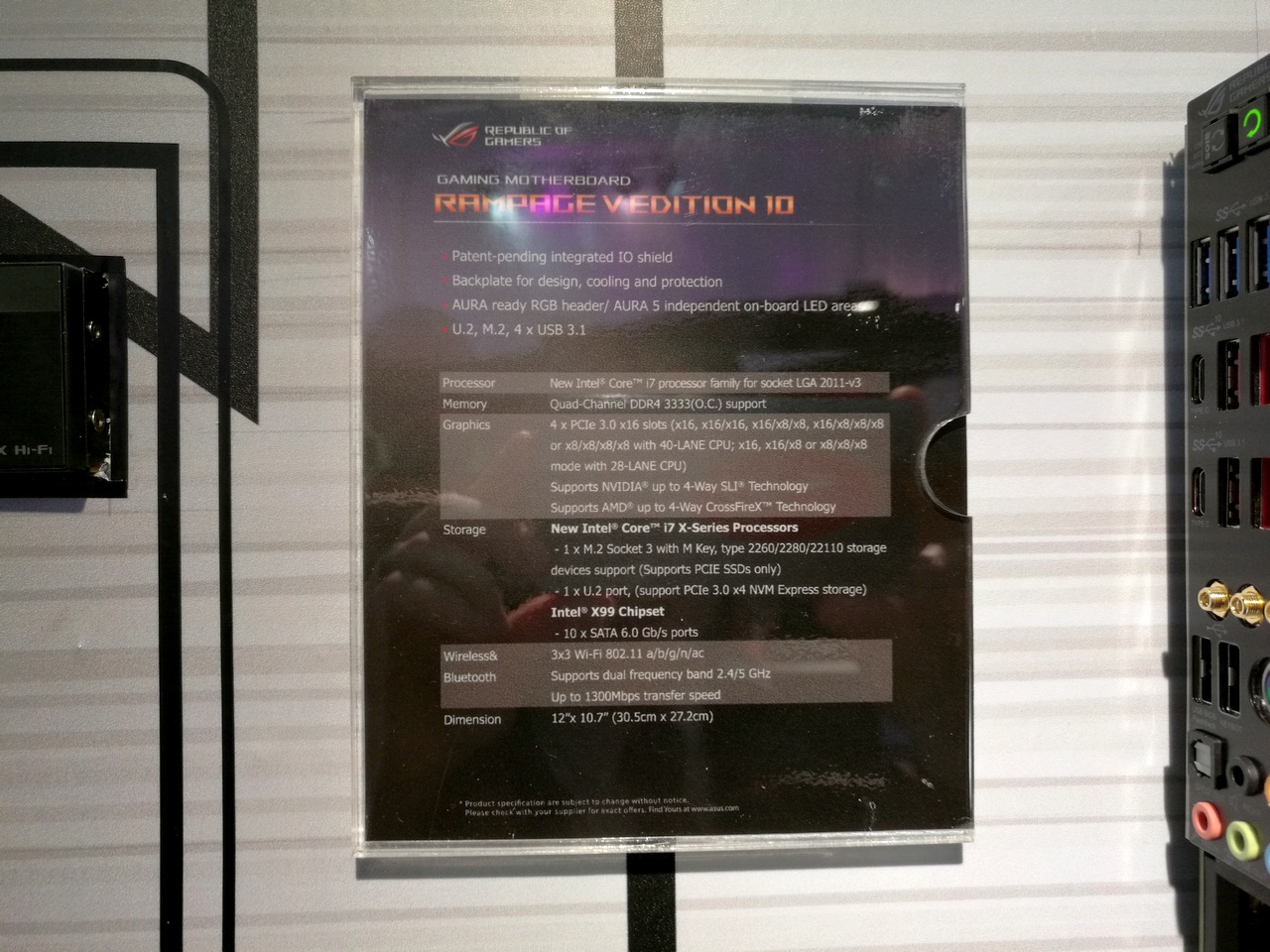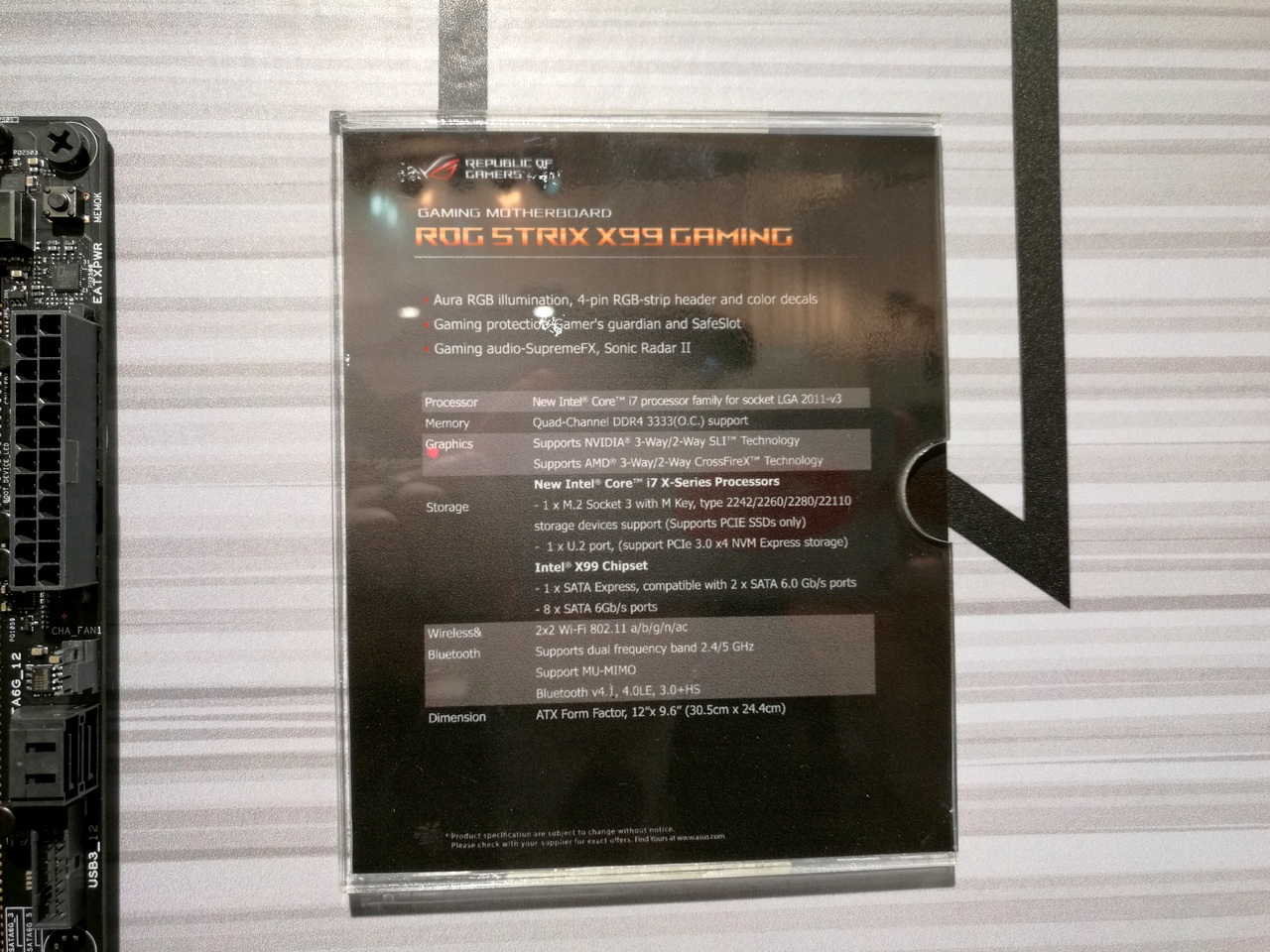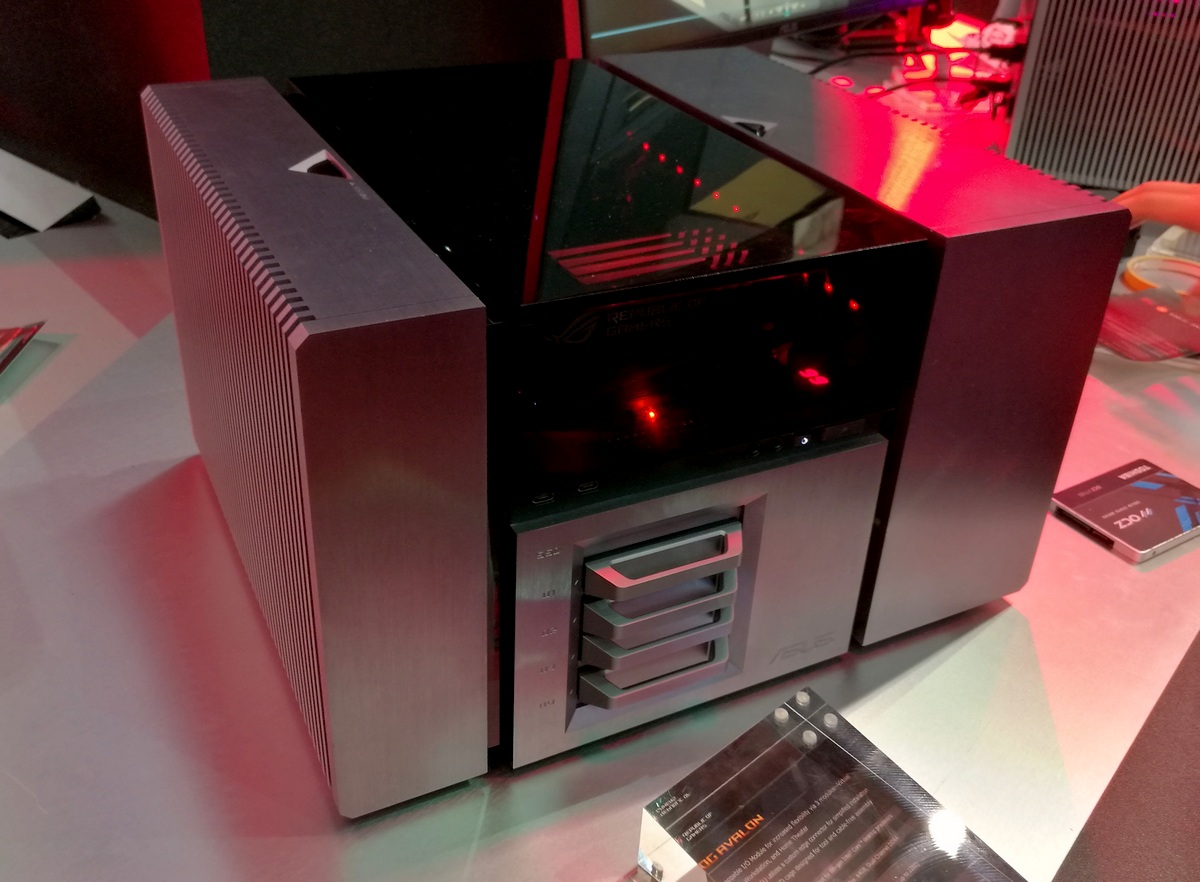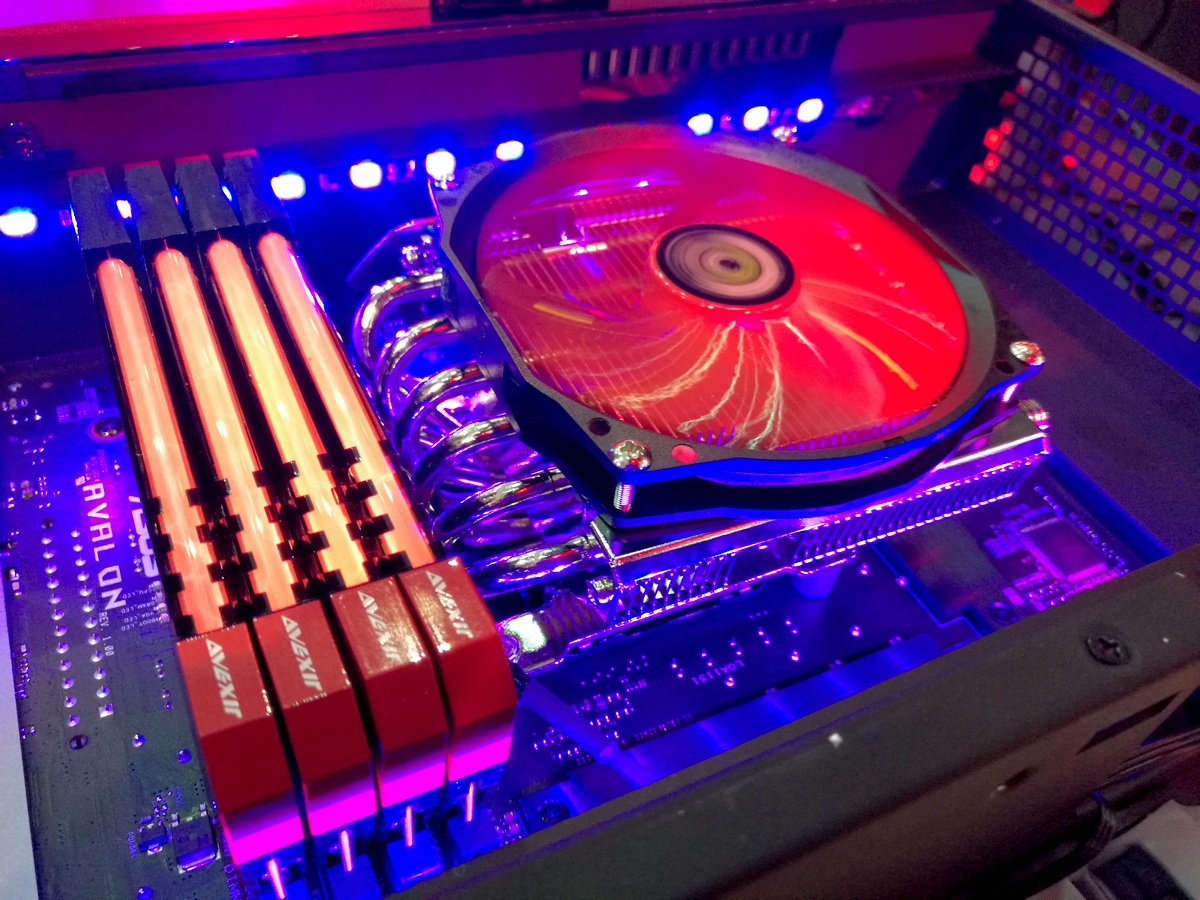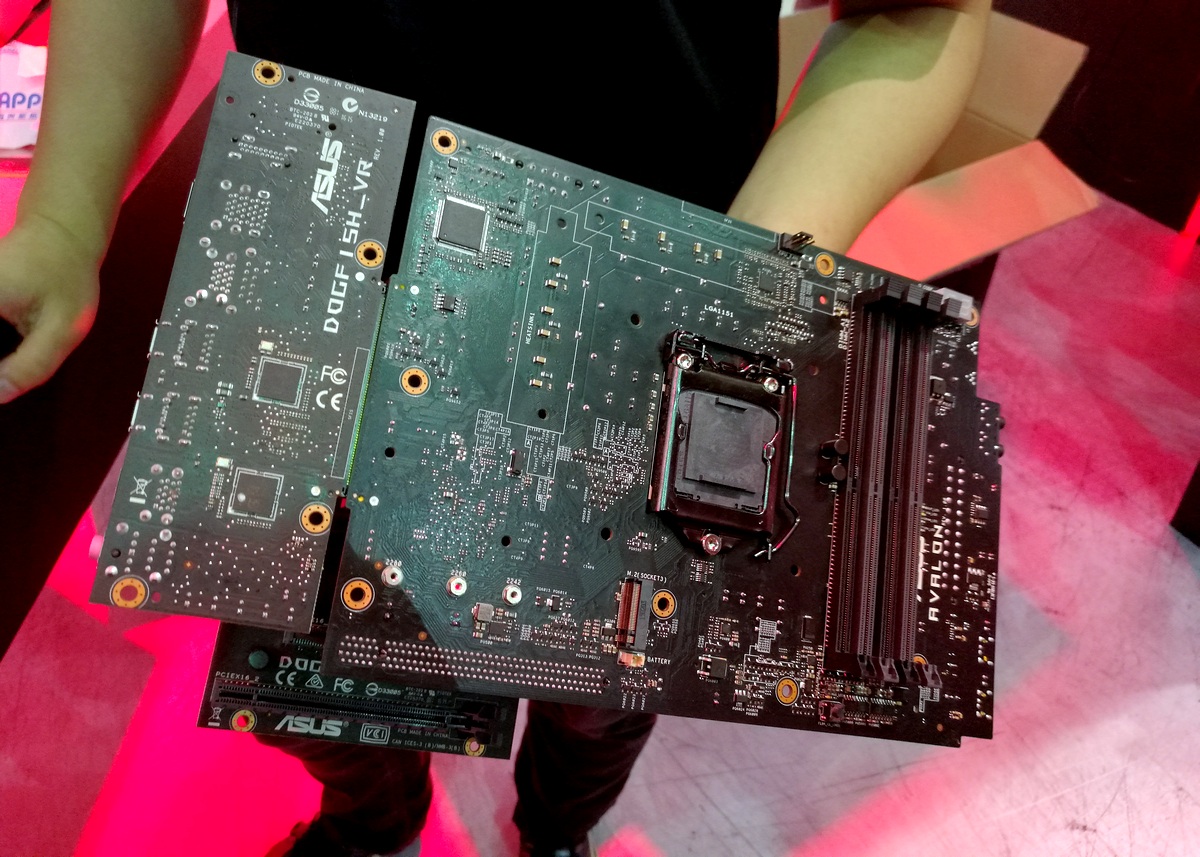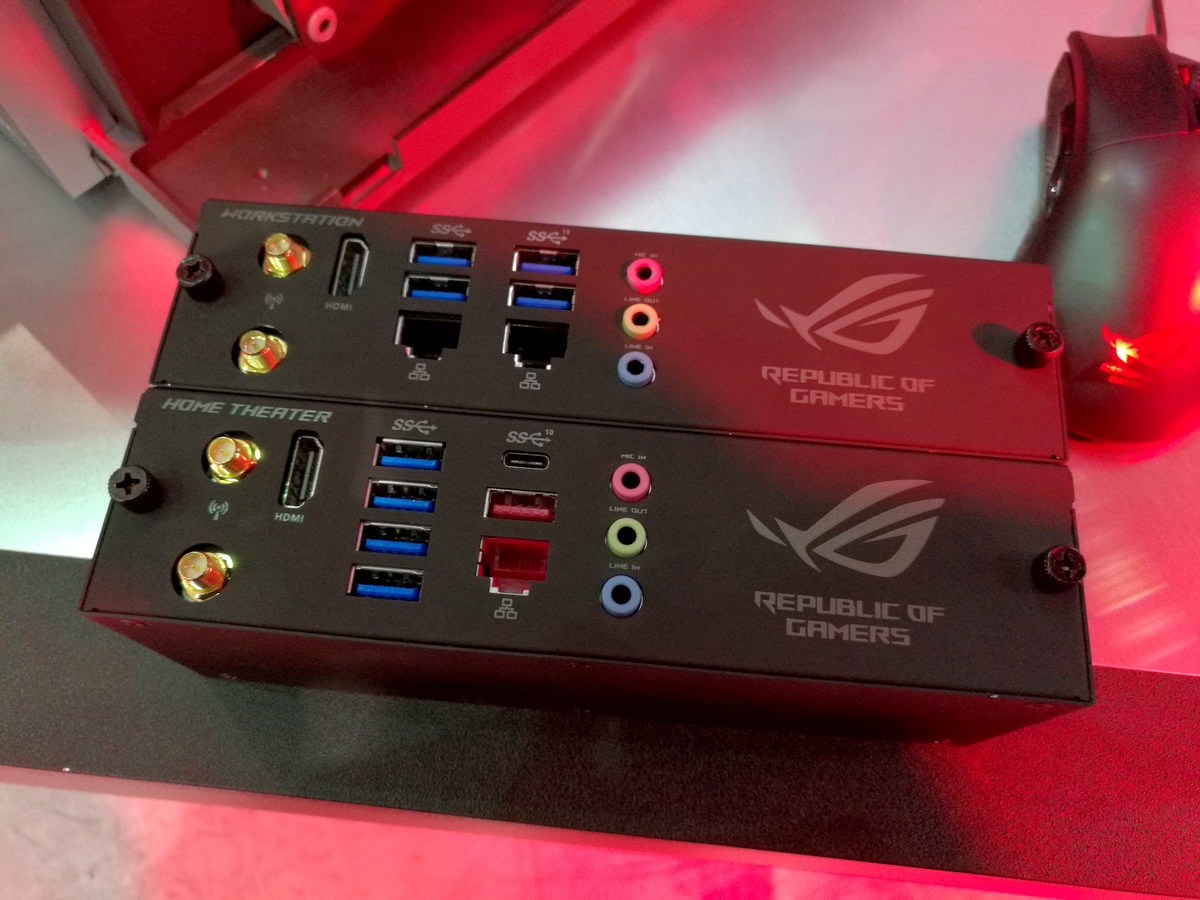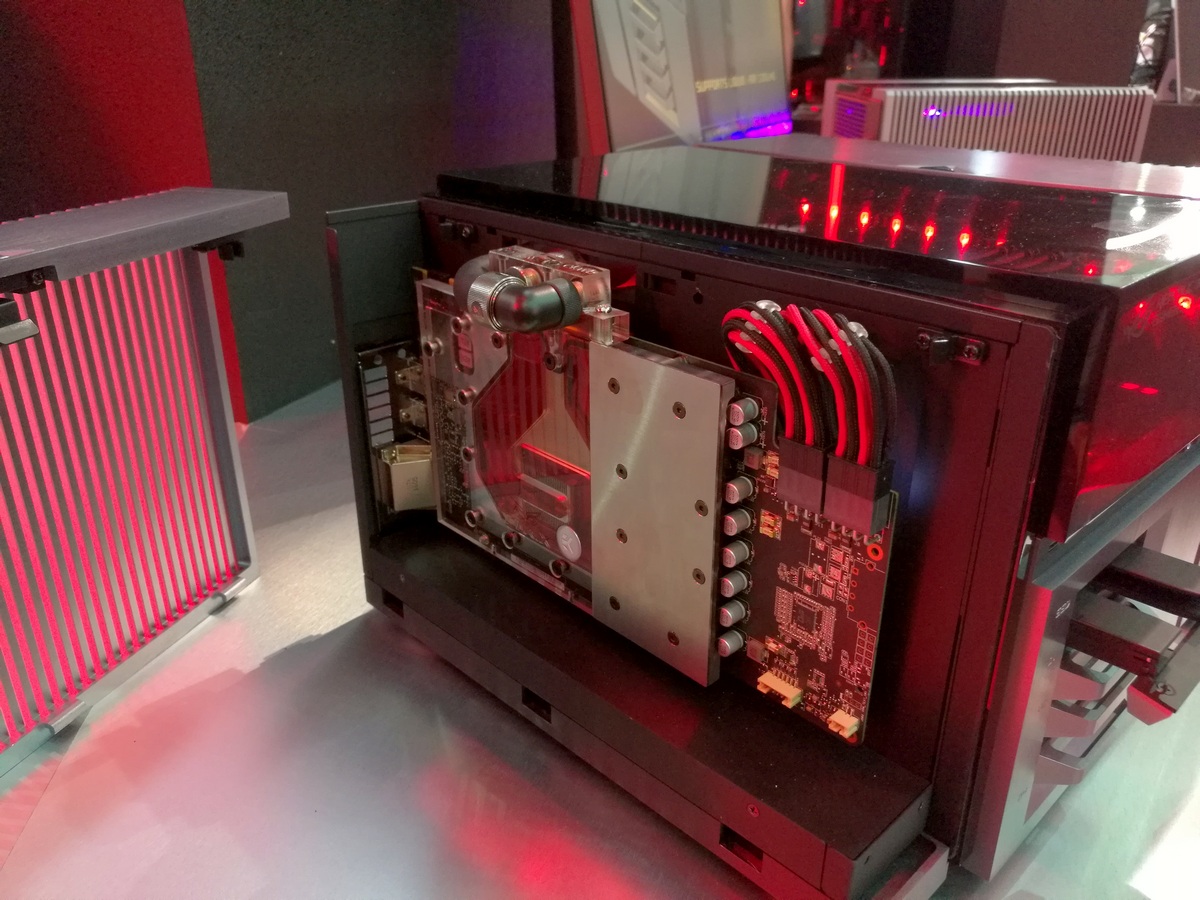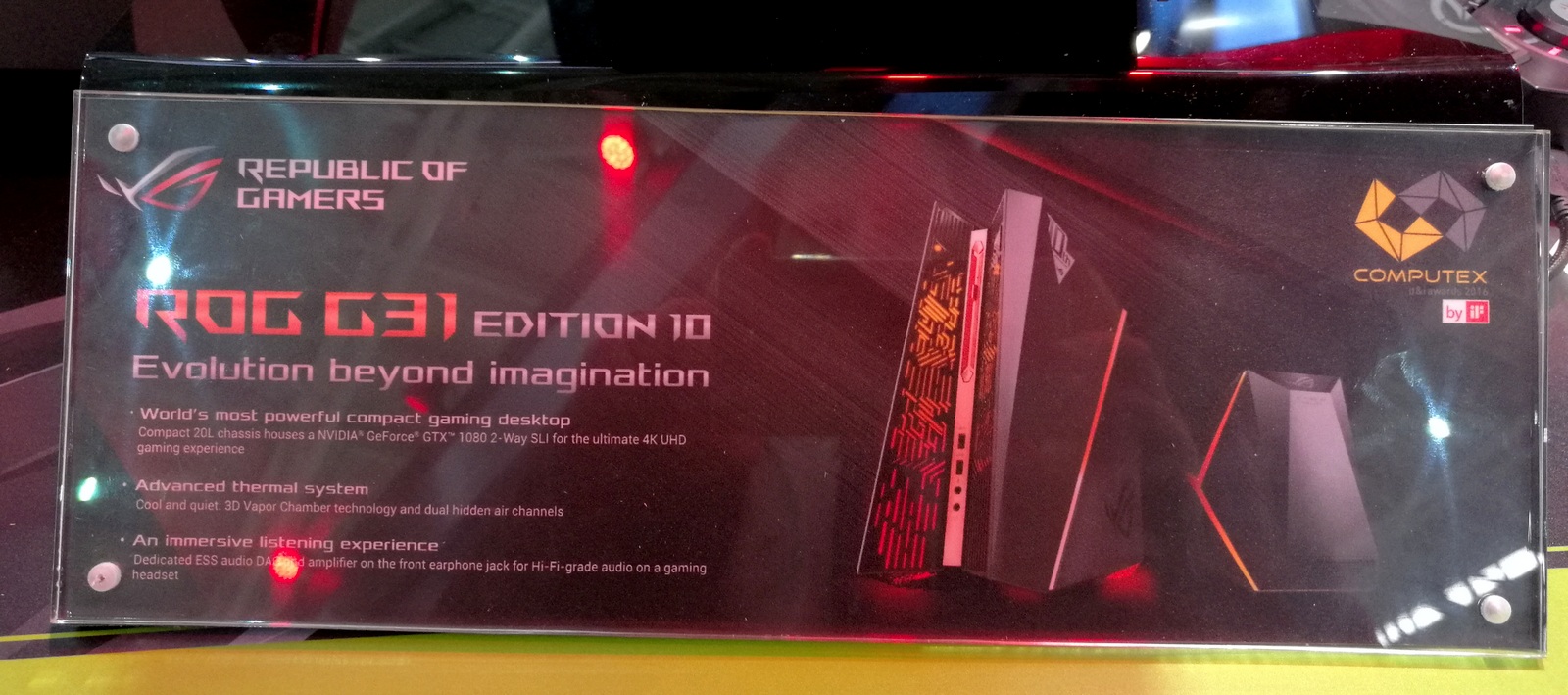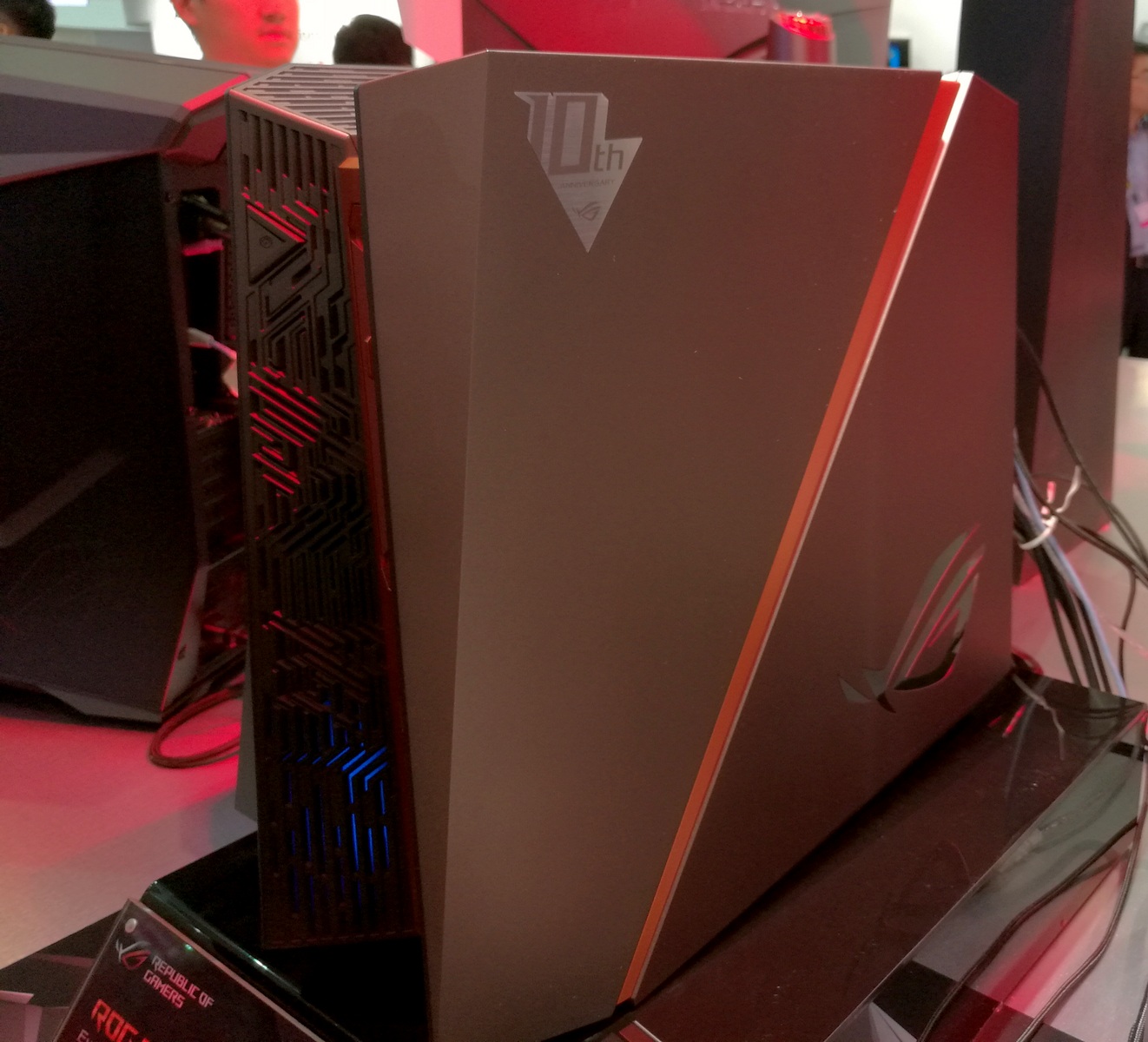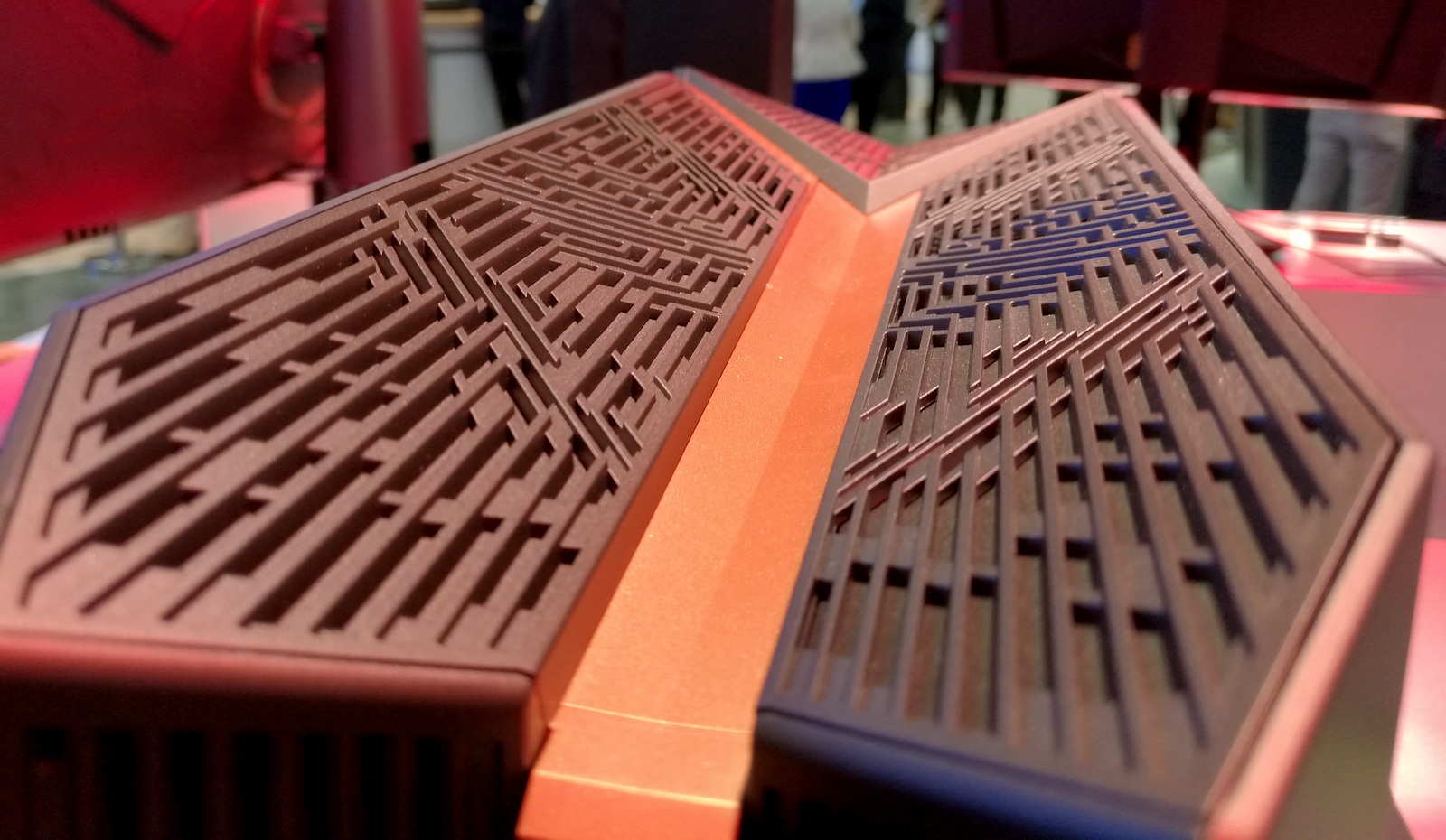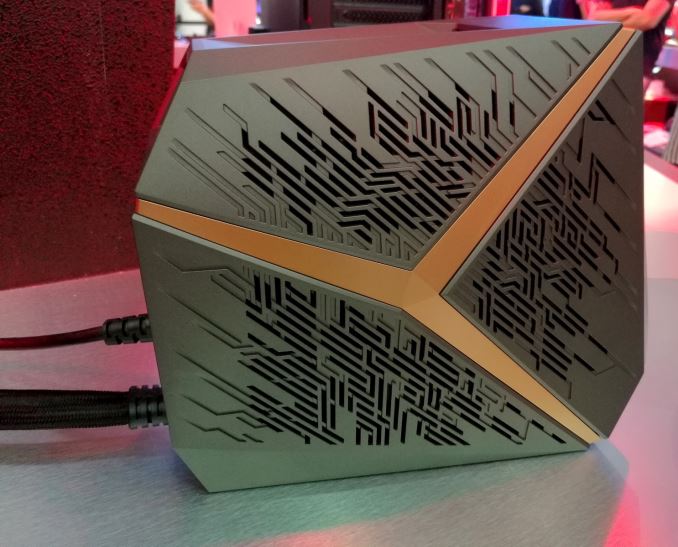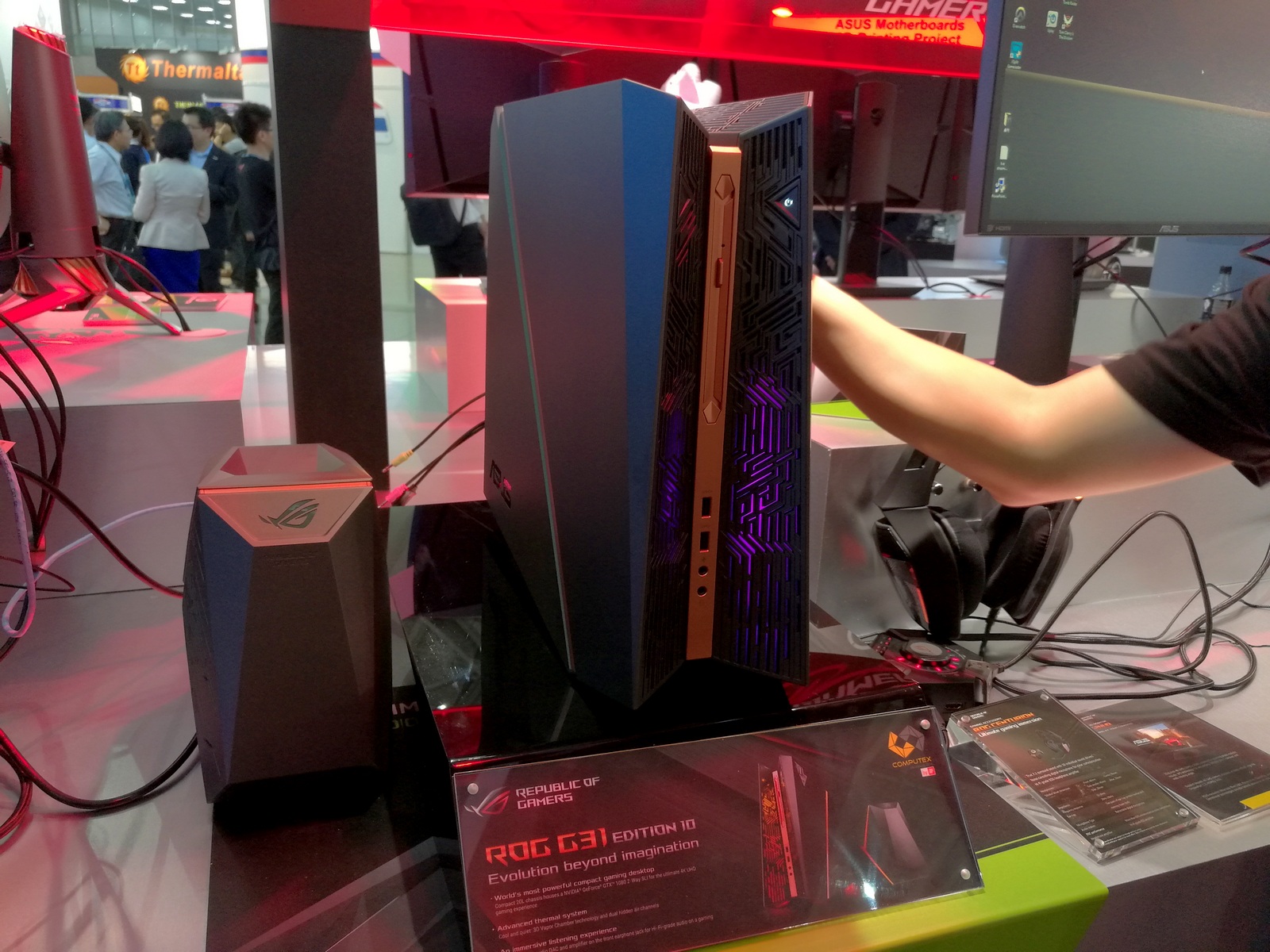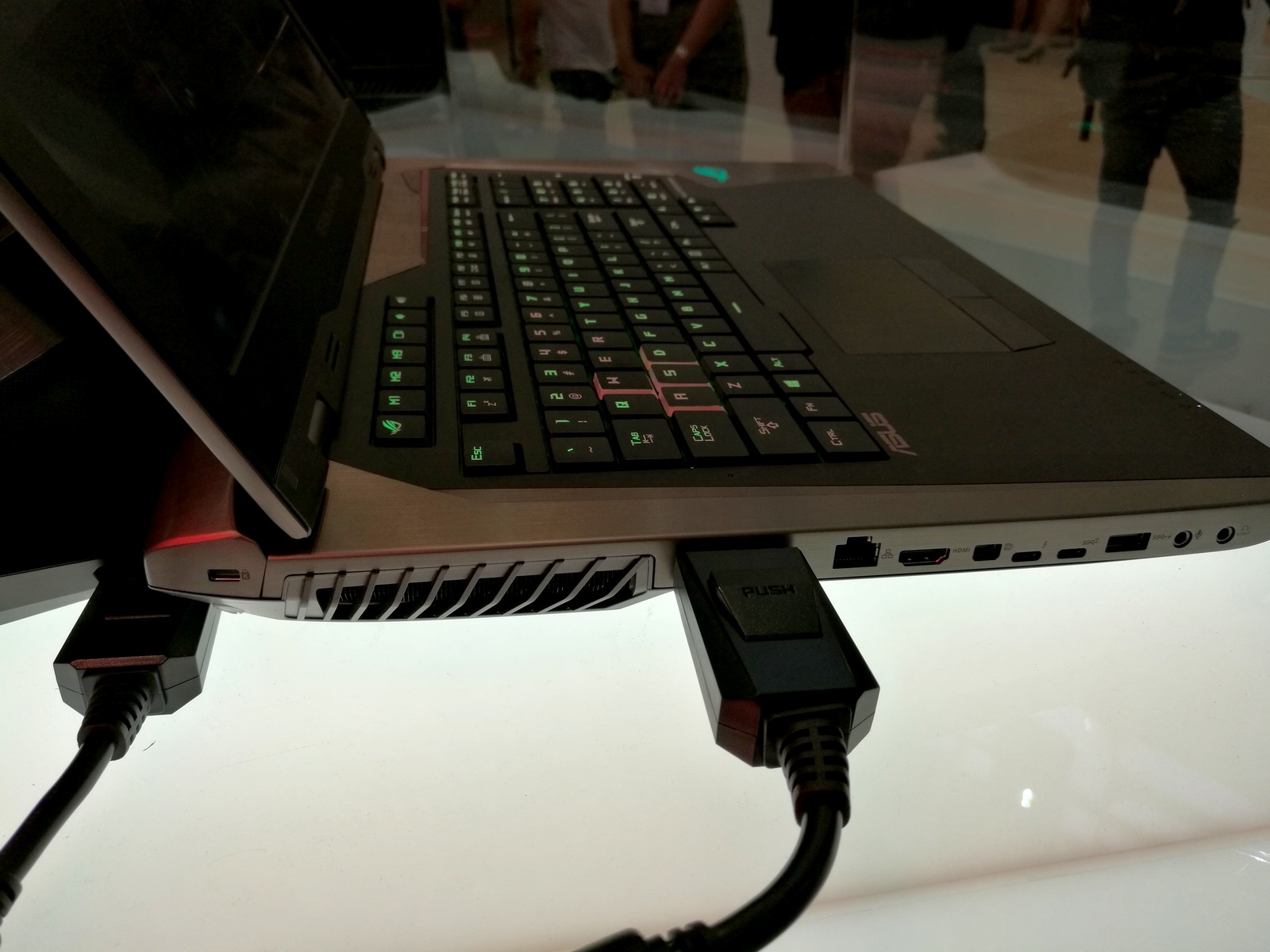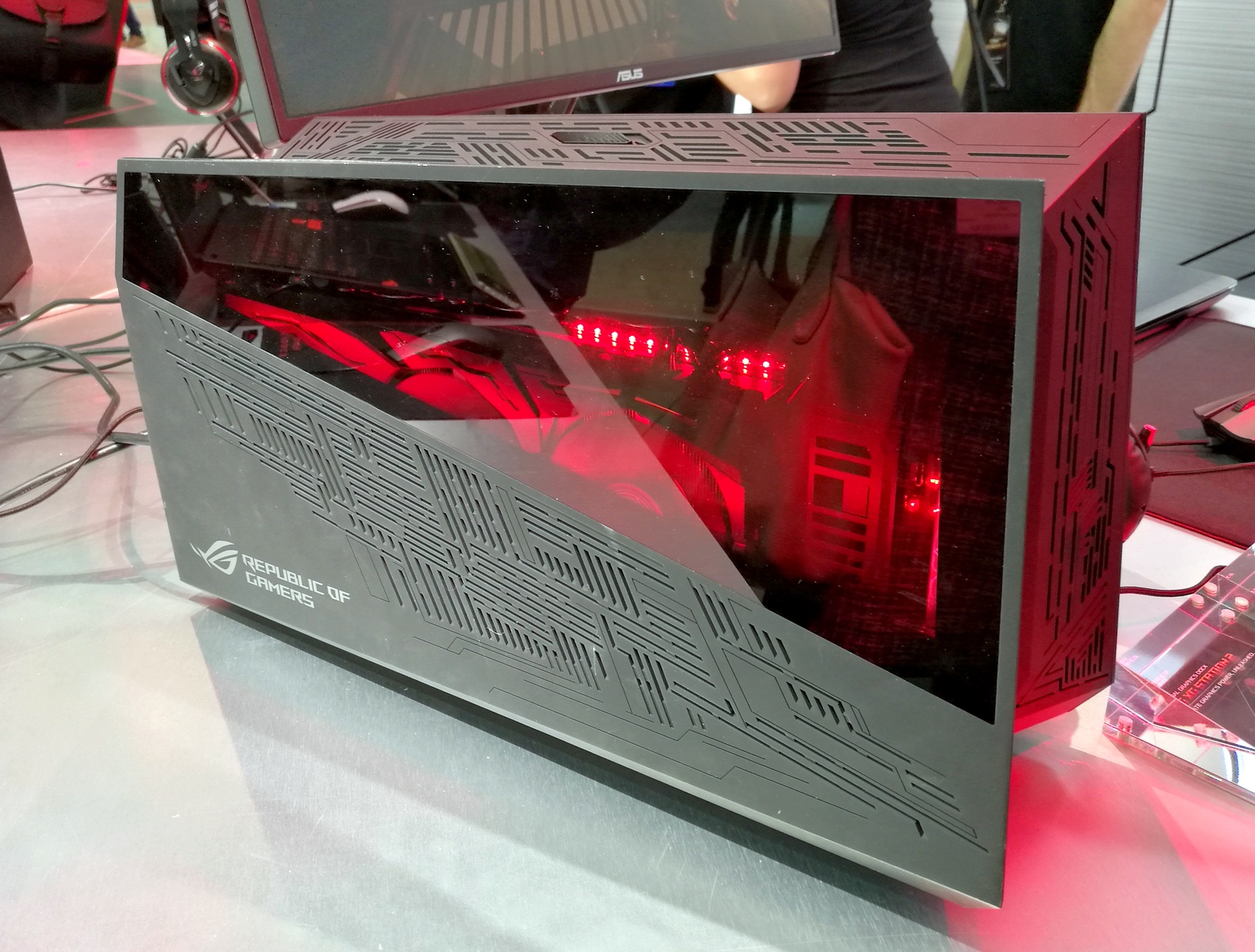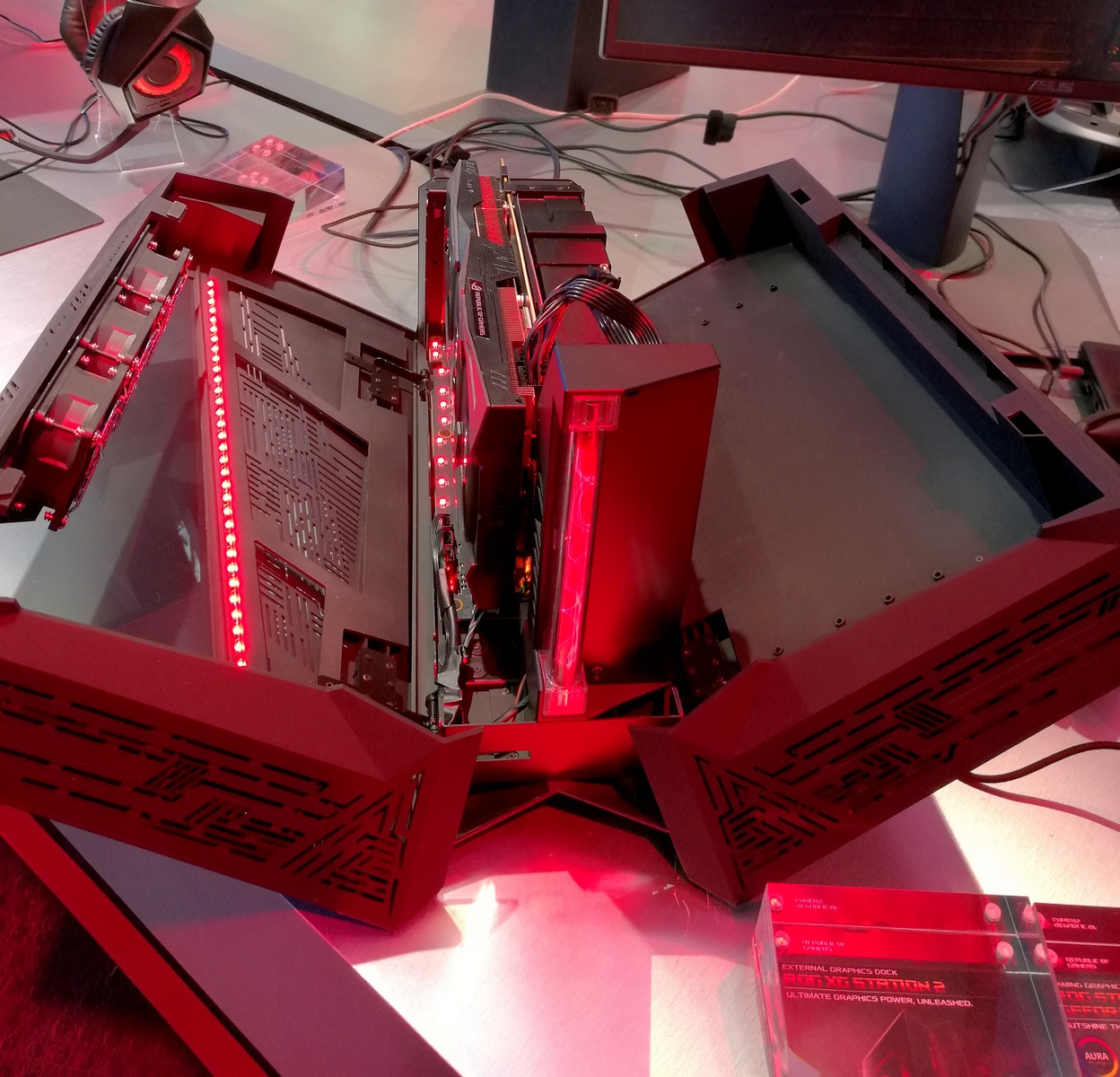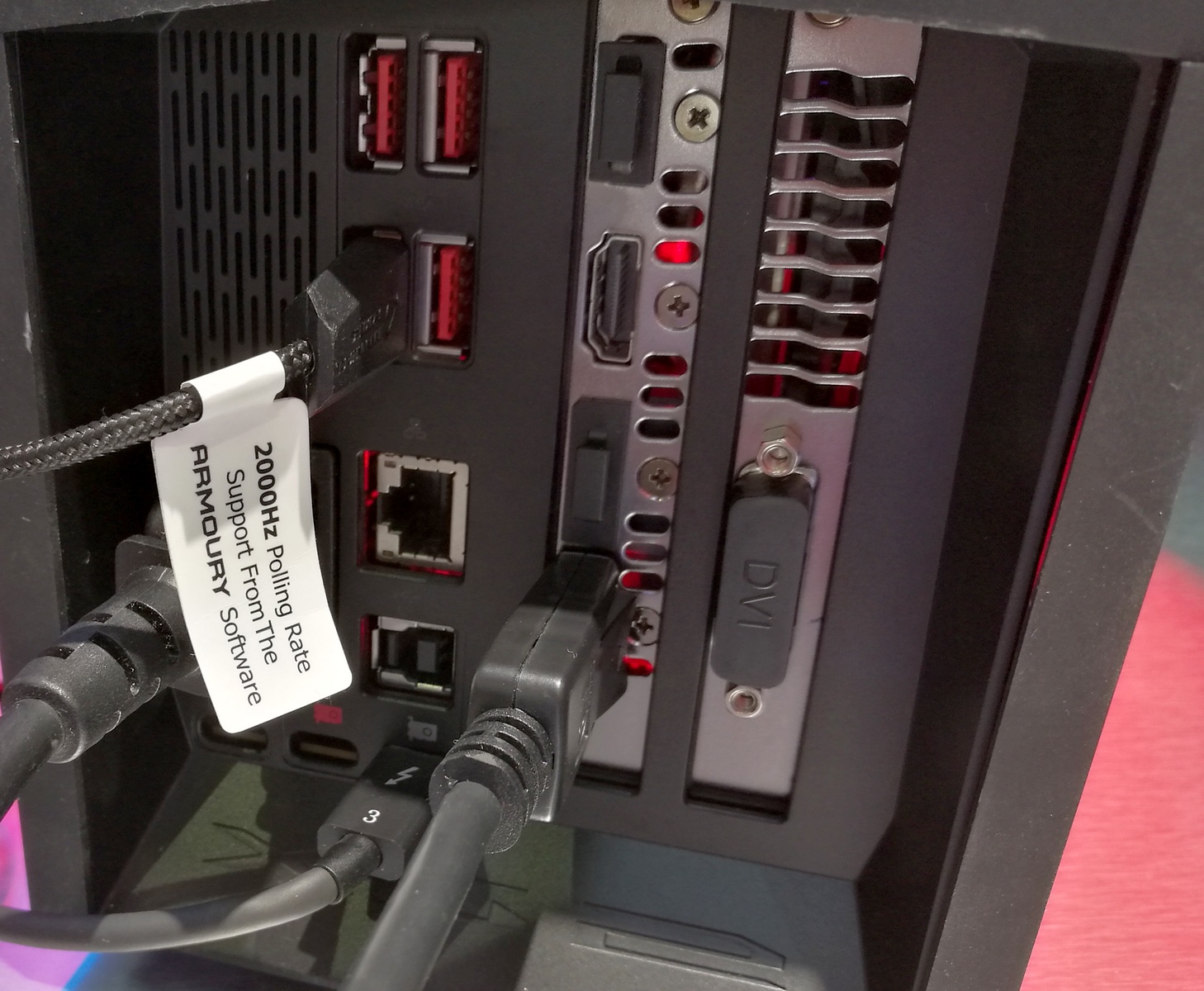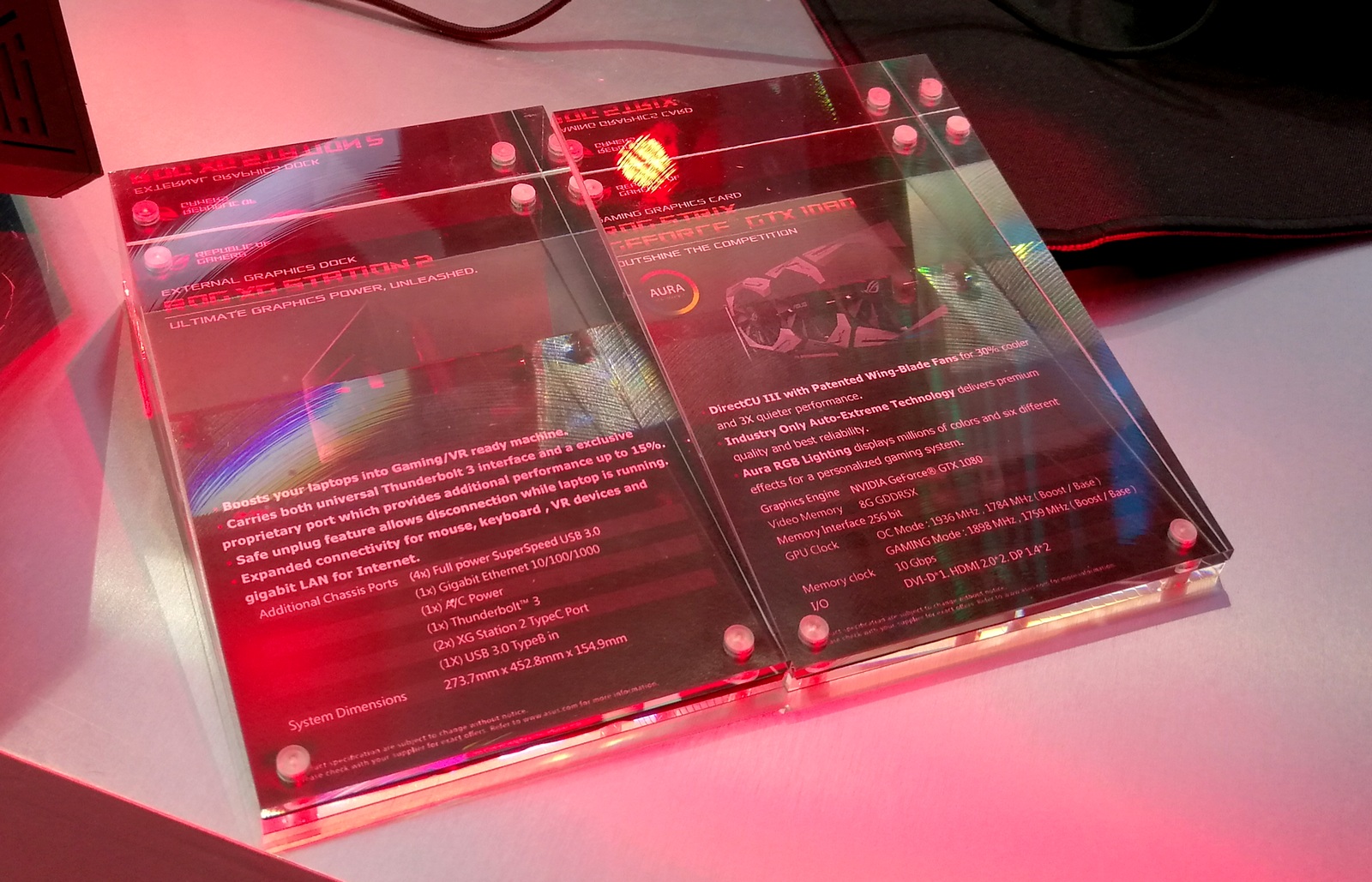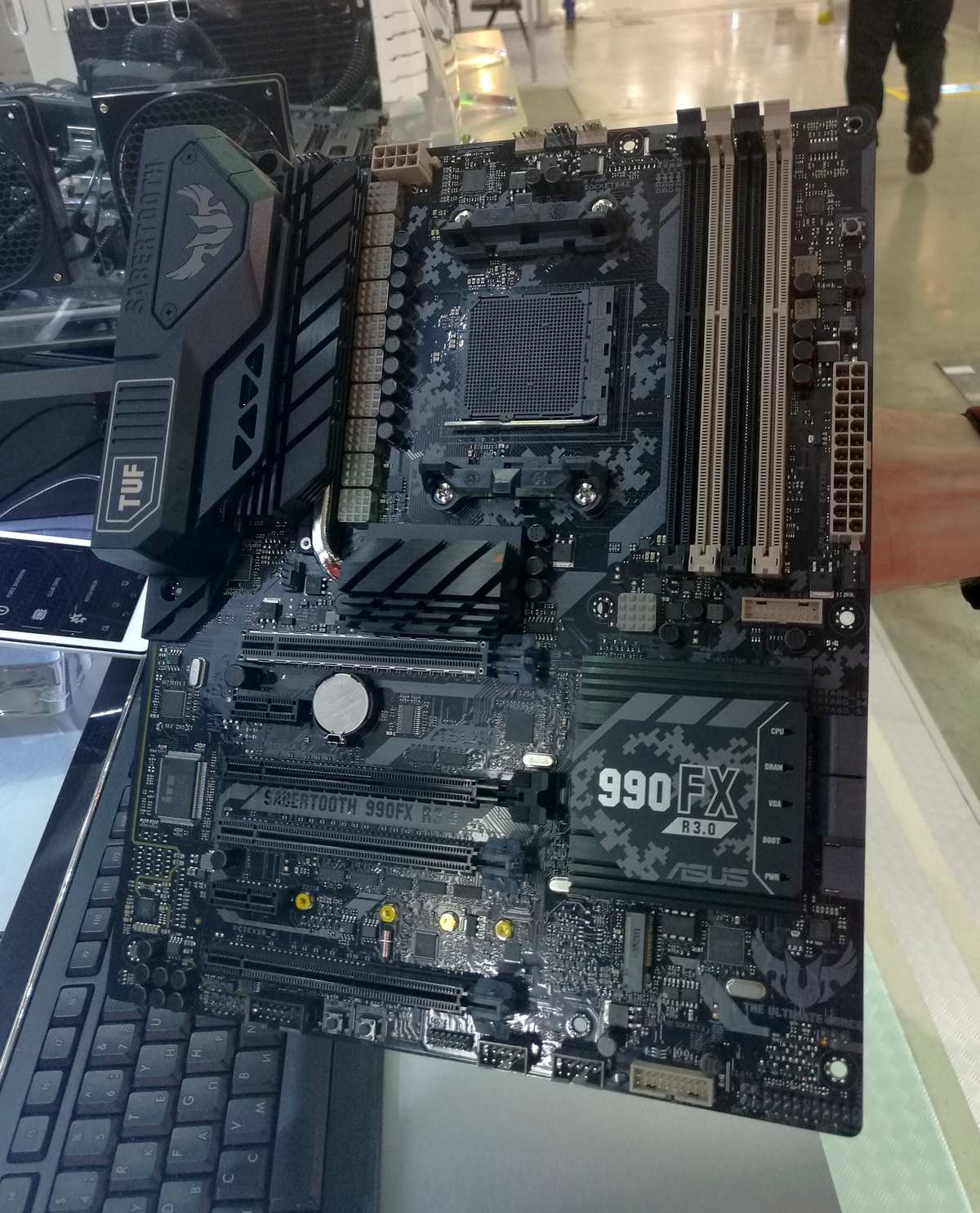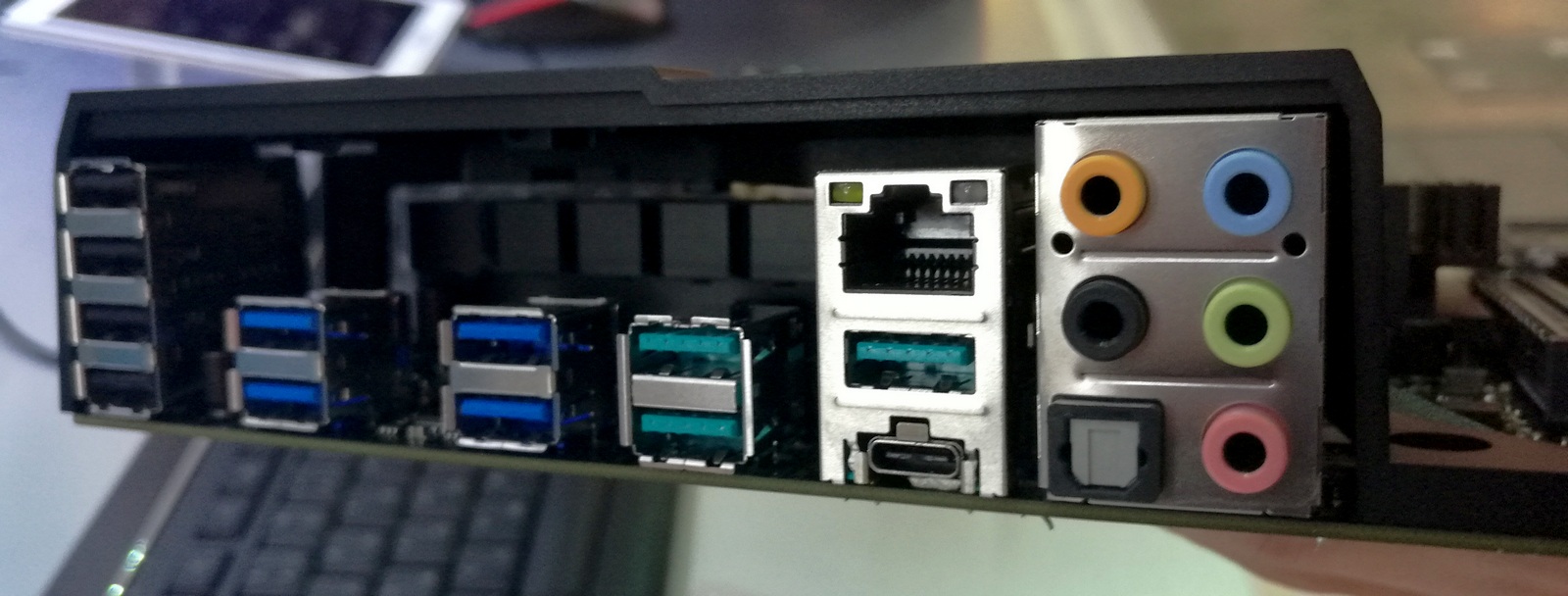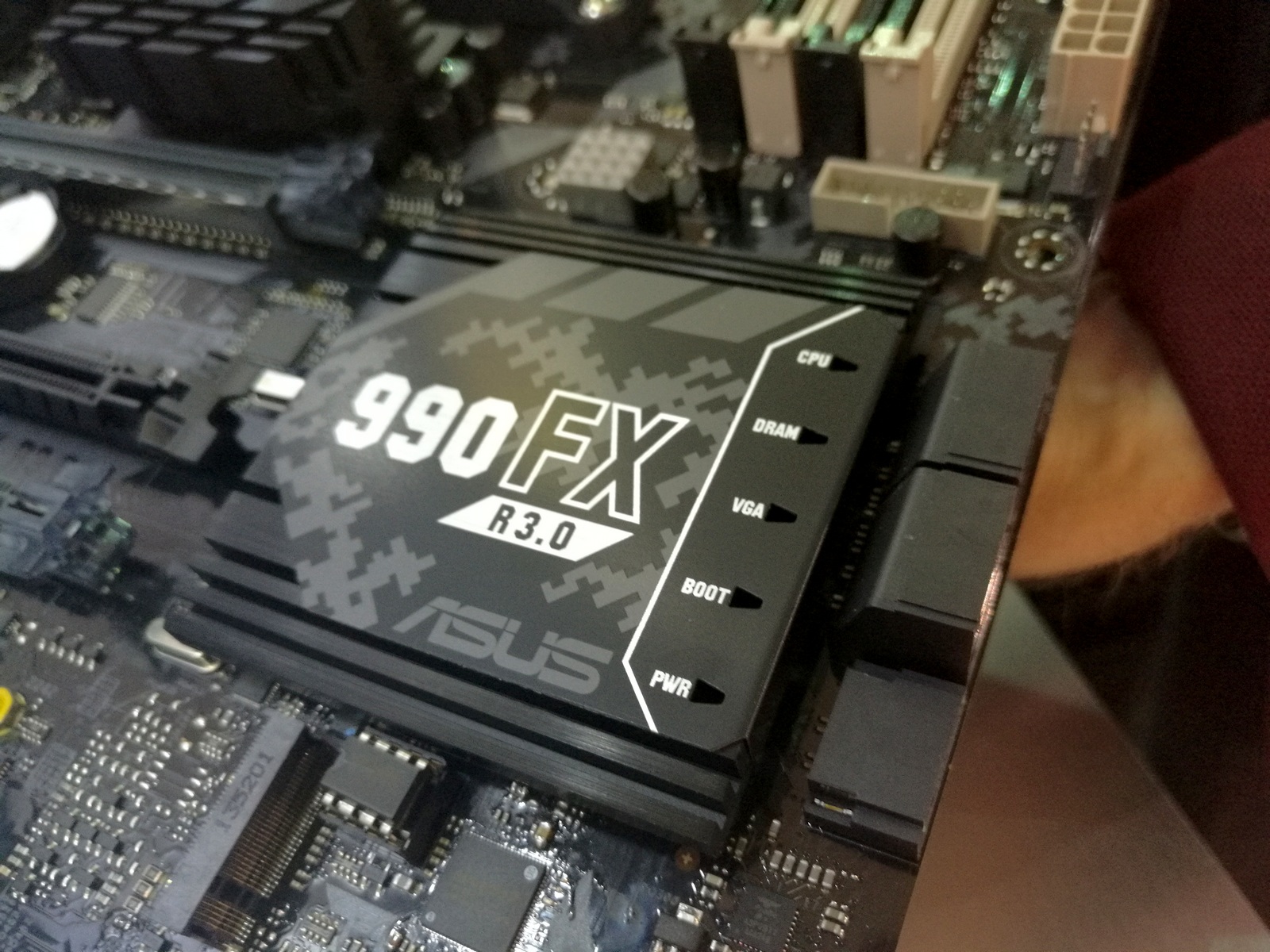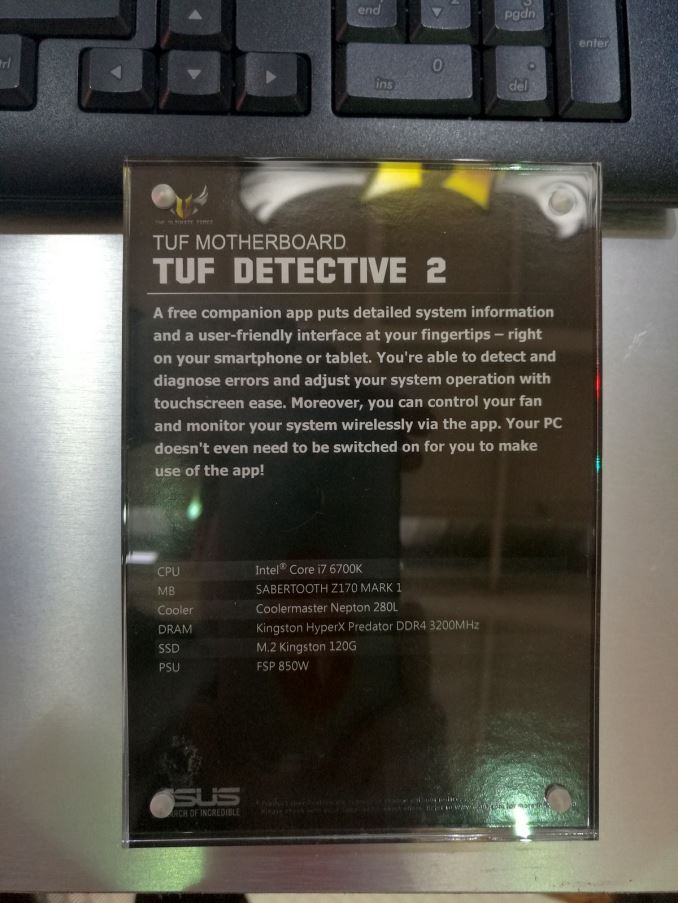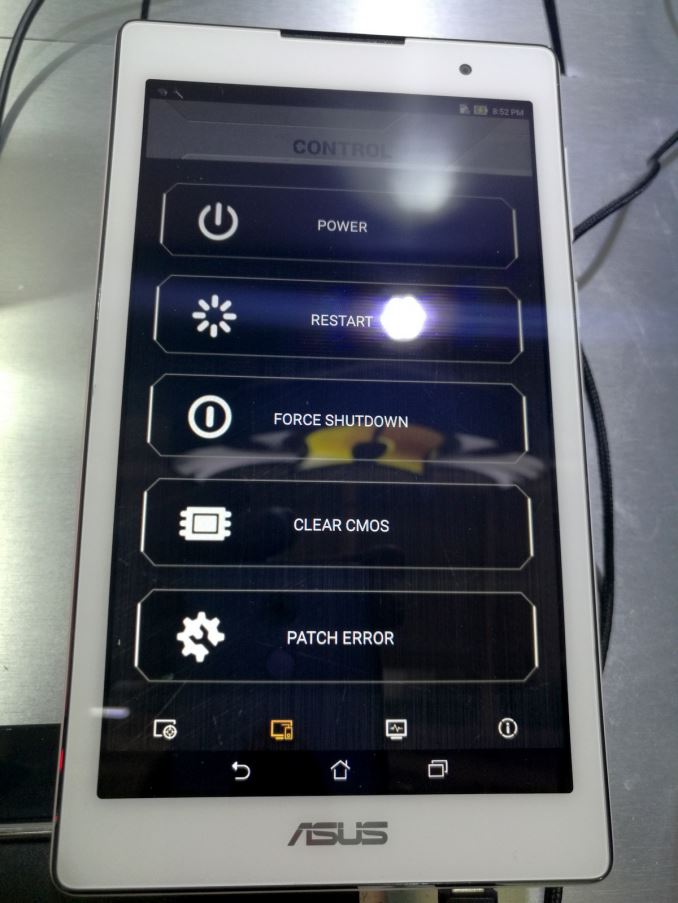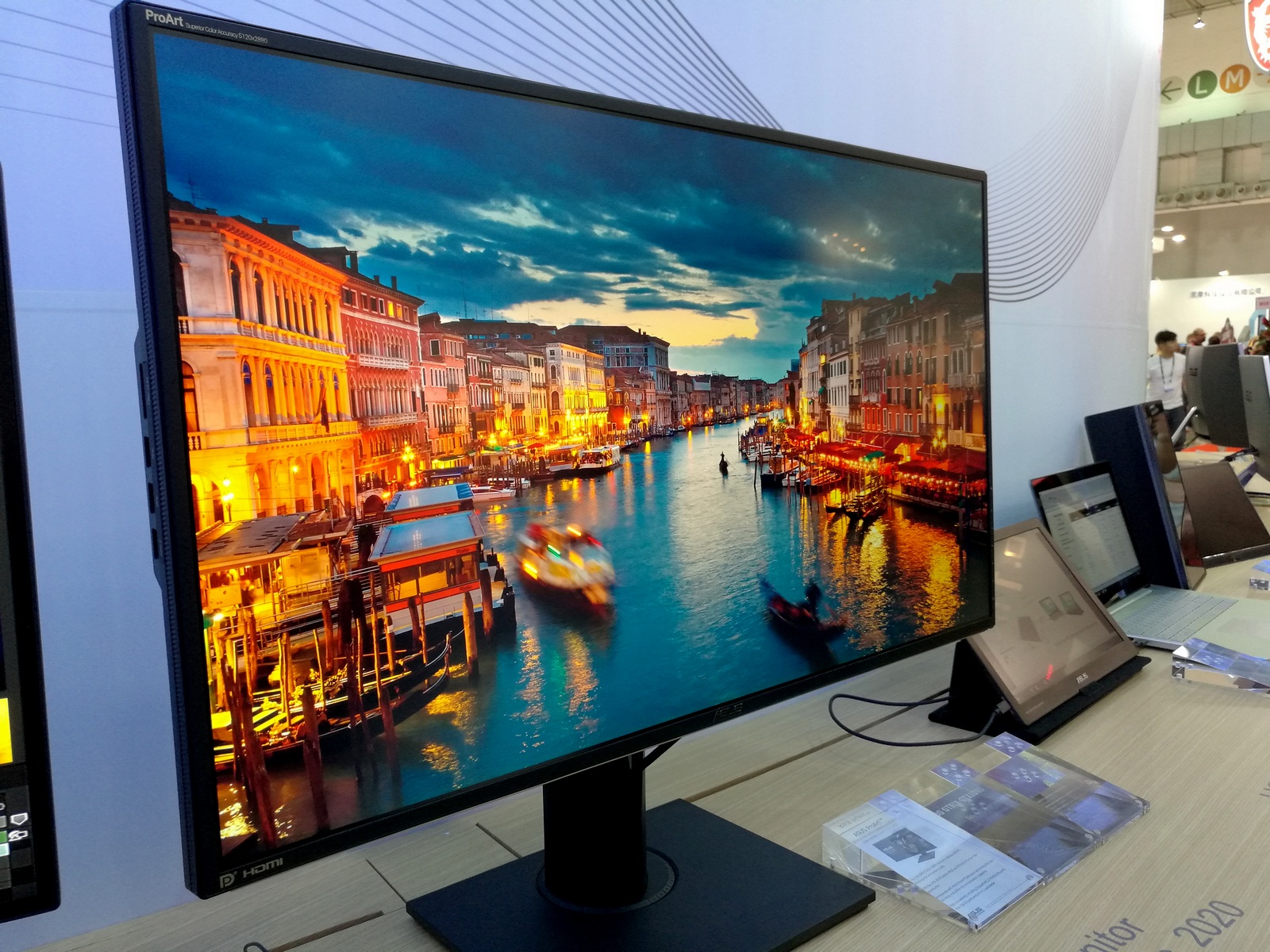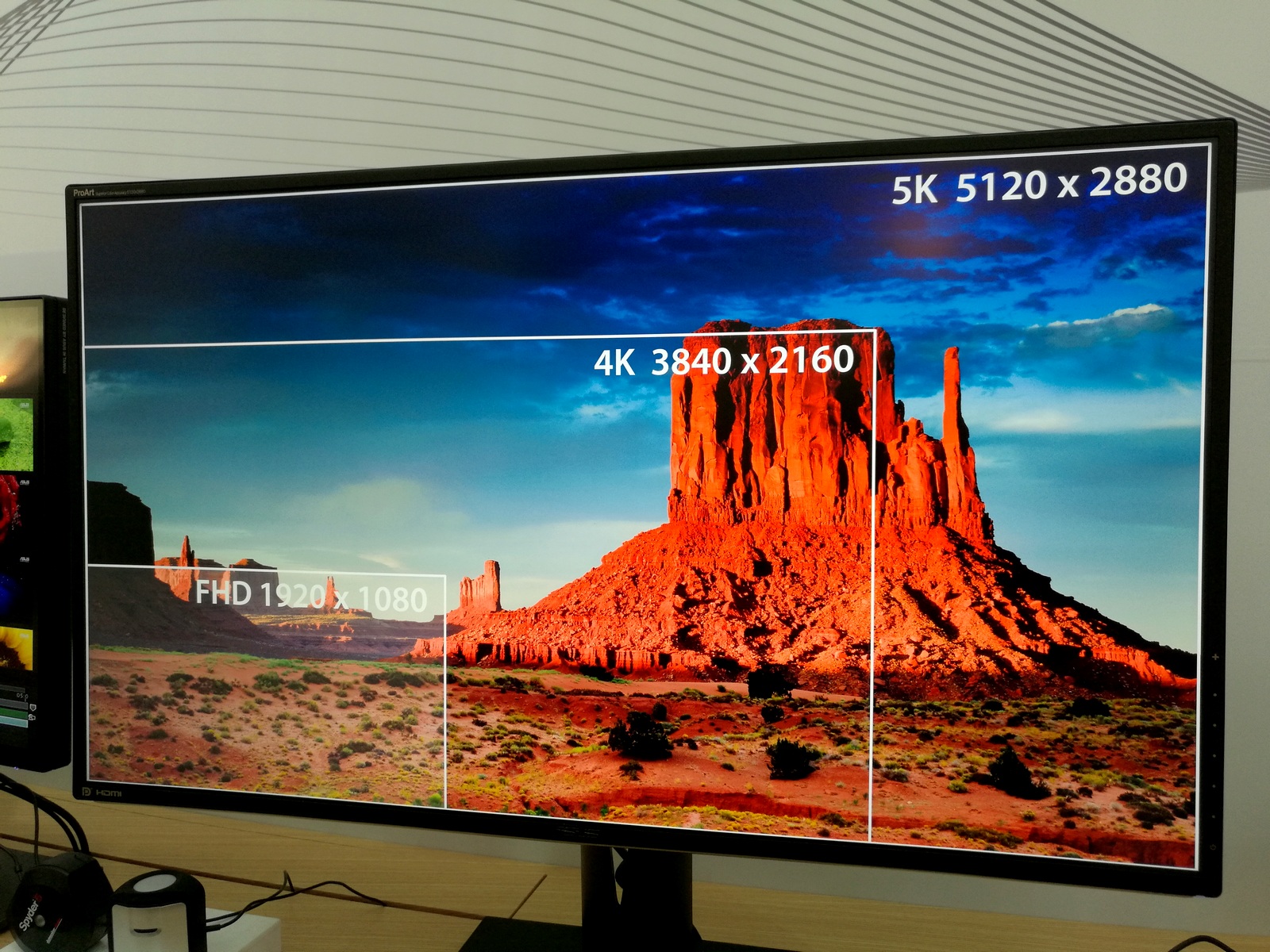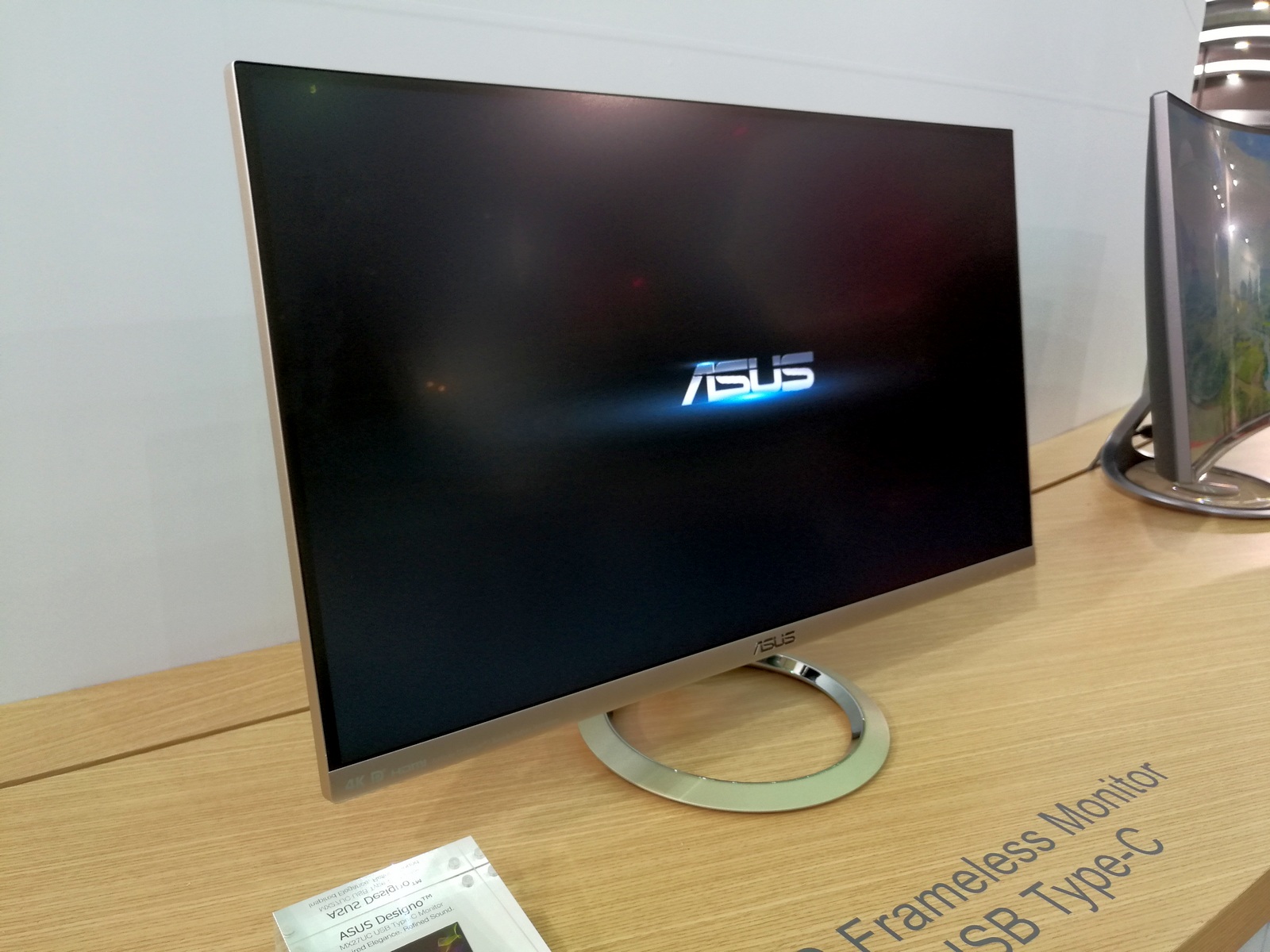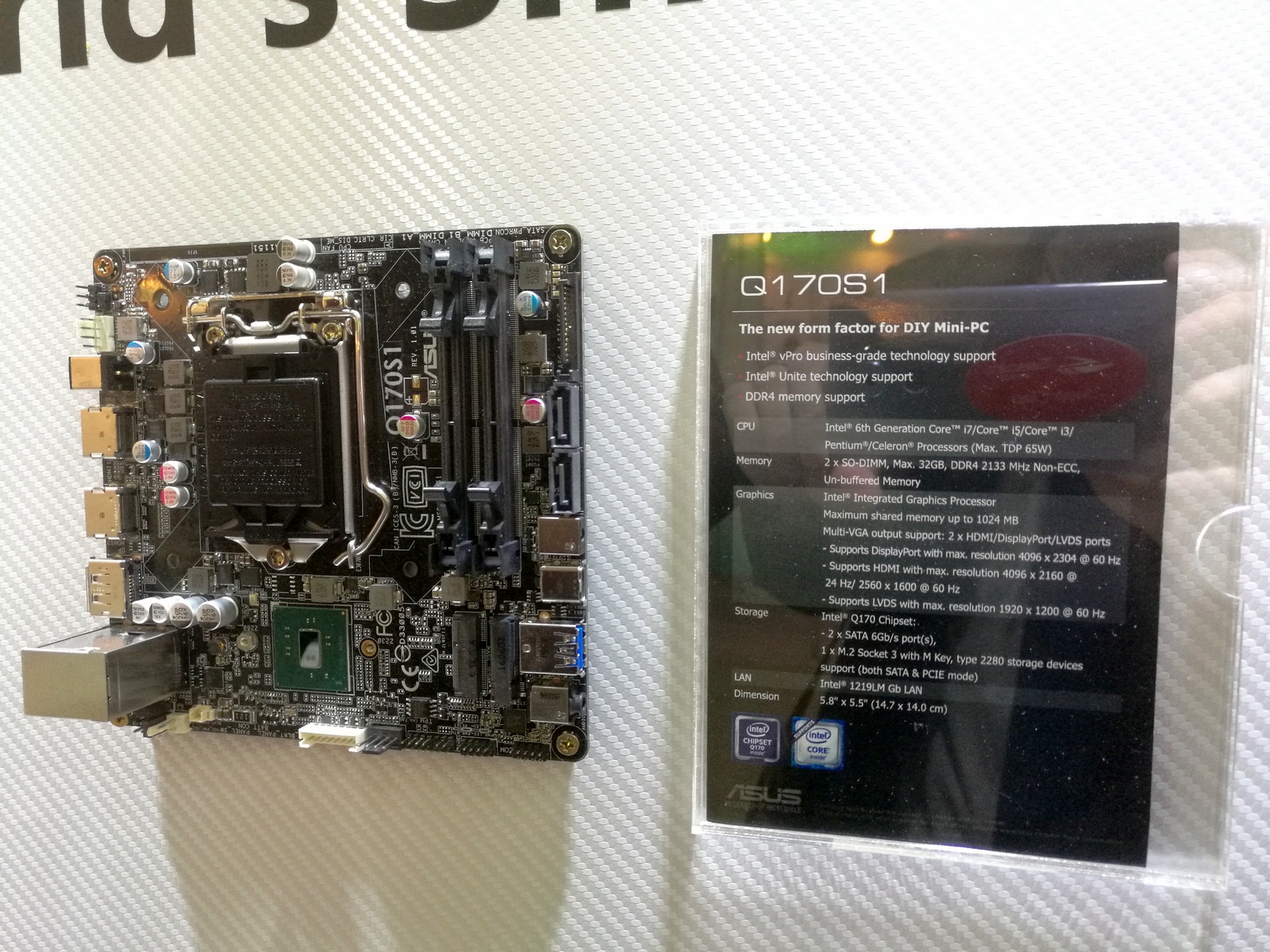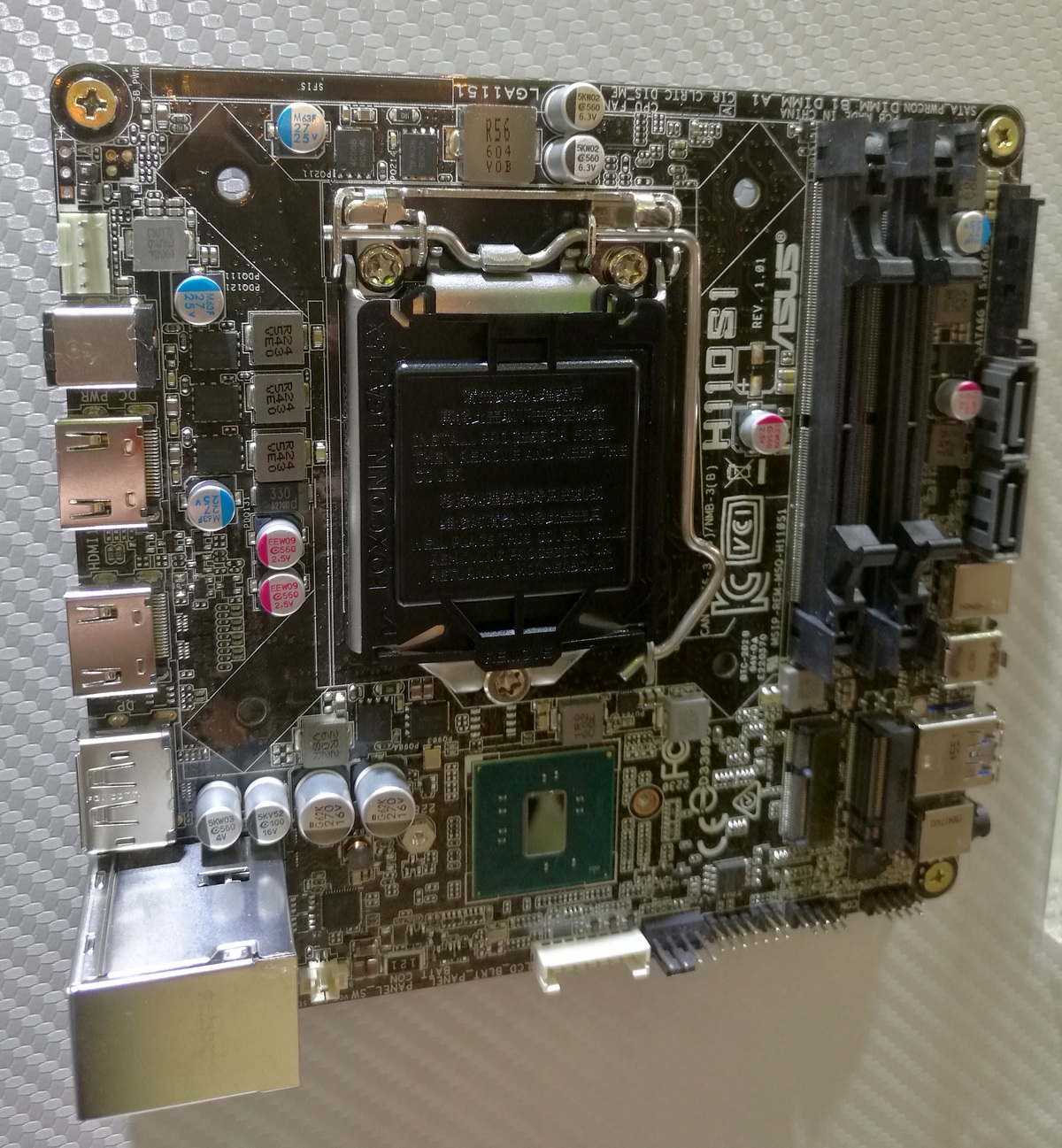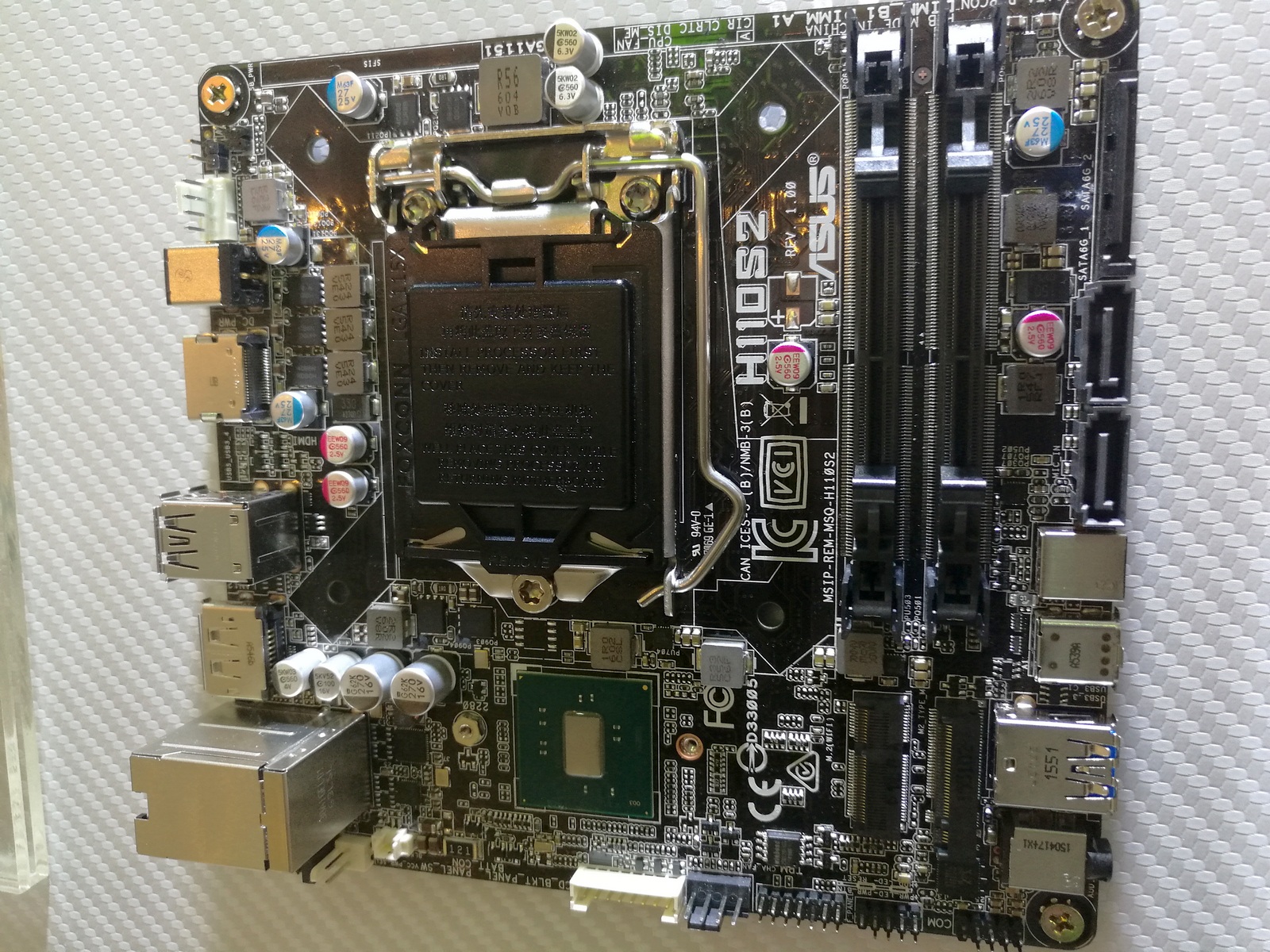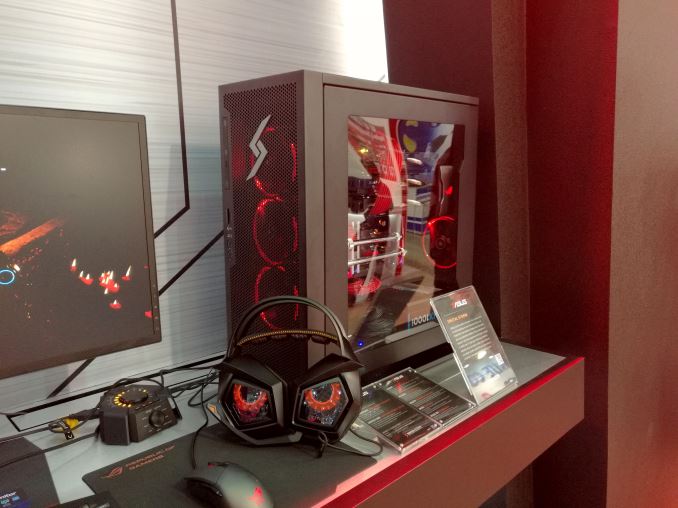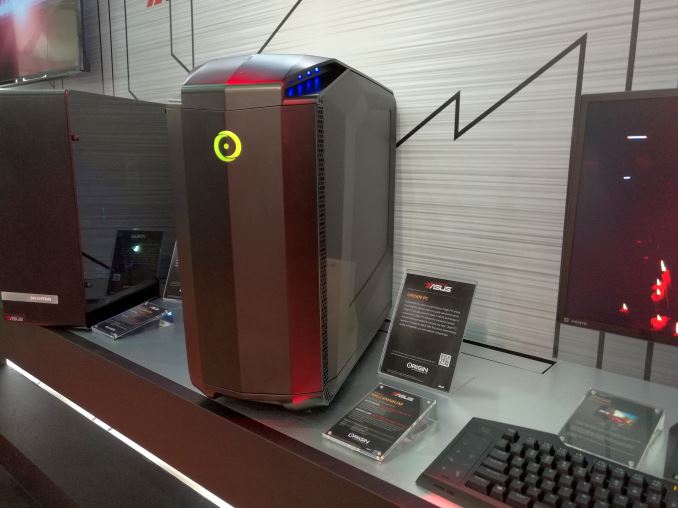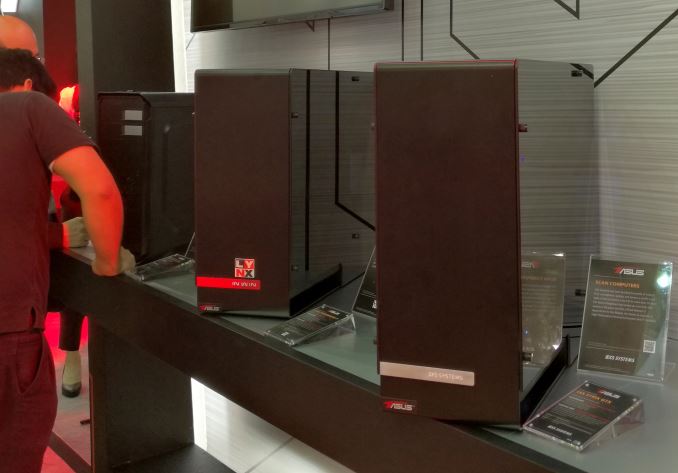
Original Link: https://www.anandtech.com/show/10434/asus-at-computex-2016-the-10-years-of-the-republic-of-gamers-rog-booth-tour
ASUS at Computex 2016: The 10 Years of the Republic Of Gamers (ROG) Booth Tour
by Ian Cutress on June 22, 2016 8:00 AM EST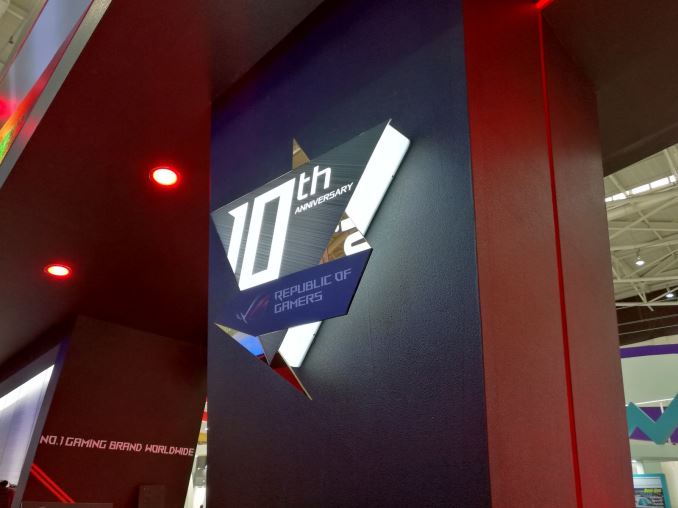
For anyone following our Live Blog coverage at Computex this year, ASUS had two large press events in quick succession in different parts of town. The first focused on the mobile lineup of launches, in an event called Zenvolution (playing off of the Zen line of products) where Jonney Shih played rapid fire with the new Zenbook 3, Transformer 3/Pro 3, ZenFone 3 devices, and a $599 home assistant robot called Zenbo. A few hours later, over the other side of town, was the annual Republic of Gamers event held in a local nightclub where Jonney Shih presented a sequence of 10th-anniversary products. The following day we made a bee-line to the show floor booth before the official opening time and went through a number of the major releases.
Marking 10 Years of ROG
We reported back in January and CES that ASUS was celebrating ten years of the Republic of Gamers brand, marking a now noticeably profitable success for the company and a very well-known fixture for users looking at gaming branded products. At the time, we headed up a round-table with two of AnandTech’s most recent former Senior Motherboard Editors (who both now work at ASUS) to go into detail about why ROG exists, what it means for users, and I also put to them a dozen or so questions from our readers.
However at the time, CES was a relatively minor show for ASUS: as a company, it was decided to cancel the intended press events and make Computex a little more special, as anything announced at CES would have launched after Computex anyway. That led the way for Computex being the primary focus for the announcements this year, not only for the Zen product line of smartphones and notebooks, but also for the Republic of Gamers. We saw the announcement of a mix of 10 Year anniversary products, prototypes, and updates over previous generations of products. ASUS also wanted to make it special, and invited a series of ‘super fans’ to the show as well as a number of gaming teams that ASUS sponsors.
Among the super fans were a few overclockers, one of which is a former team member of mine in the most prominent overclocking leagues, as well as an ROG user who had acquired all (or almost all) of the ROG motherboards that have ever been released, with a total expenditure exceeding $10,000. He also had a few GPUs for good measure.
The ASUS ‘10 Years of ROG’ press event felt somewhat eerie: if someone in attendance had no idea of what ROG was, it felt almost like a cult leader of an army, and sure enough ASUS’ Chairman, Jonney Shih, came out in a knee length custom leather jacket, cap, and the title ‘ROG Commander-in-Chief’. Follow lots of low-frequency bass lines, a laser and smoke show, and technology reveals by ROG Generals, and you might not realize that this is actually just a product launch. When it has one, every brand enjoys a loyal following when users invest their money into that brand or product line, and it was clear that ASUS enjoys extrapolating the ideals of their following to a user army-like status.
Nonetheless, the product announcements were thick, fast, and lacking in just enough detail to force the press to crowd the limited samples on hand on display in the nightclub. At the time when the press event finished, Billy went for a stroll around the new products (as all the other media charged the demonstration area) while I closed up a few emails, but we waited until the following day and was able to browse the ASUS ROG Booth before the official opening time and before the mêlée of other press descended on what felt like the biggest booth at the show.
We saw a number of new products, and a big part of the show in general was the attention to detail by users who modify cases (or modders for short) that companies commission special show builds for. ASUS had a number of these on display as well, ranging from elegant to crazy. This includes custom system-integrator and retailer designed systems, such as the newest tri-loop cooled 8Pack designed system claiming to be the fastest overclocked system you can buy in the world. We interviewed 8Pack at an OverclockersUK event a couple of years ago, which you can read here.
So, in no particular order…
Ever since the monitor market became commoditized, and reasonable 1080p displays running at 60 Hz can be had for under $100-$150, the march for feature set has been driving the monitor industry, the gaming industry, and arguably the VR industry forward. A number of groups of users, in particular gamers, are consistently requesting high quality, high resolution displays with high variable refresh rates in order to have the best experience, and they seem willing to be prepared to pay for it. Other features such as color accuracy are also lauded by the professional community as well.
But in particular, the high resolution and high-frequency monitor technologies have been exciting to follow as we have moved from high definition (1280x720, or HD) to Full HD (1920x1080, or FHD) then 2560x1440 (WQHD), 3840x2160 (‘4K’ or technically UHD) and 5120x2880 (‘5K’), and with refresh rate from 60 Hz to 75 Hz, 90 Hz, 100 Hz, 120 Hz and 144 Hz, with variable refresh rate technologies such as NVIDIA’s G-Sync (a closed standard) and AMD’s FreeSync (an open standard) all in play. The higher refresh rate, aside from updating the gameplay on the monitor quicker (if rendered frames are available) has the added side effect of also synchronizing the user input with the gameplay. Ultimately when moving the mouse in an arc, if the frame rate causes the game to only accept mouse input at 15 points on the arc rather than 75, then a less accurate arc is drawn and can cause the user to have to compensate.
Typically resolution, refresh rate and panel quality is similar to a set of scales: due to the data rates required for high resolutions, these typically run at standard refresh rates, but high refresh rates require smaller resolutions and specific monitor panel types that can respond in a sufficient time. Ultimately, for the last number of years, users who wanted a refresh rate at 120 Hz or above monitors have been stuck at Full HD resolutions using TN (twisted nematic, a type of behavior exhibited by a common family of organic liquid crystals) panels with poor viewing angles. As the technology has matured, we are starting to see either higher resolution TN panels with high refresh rates, or better quality panels at high refresh rates with better color reproducibility and better viewing angles. Aiming for the technology that can support everything is tough, and it needs time to mature.
So when ASUS and others start dropping super high refresh rate monitors, we sit up and notice.
A G-Sync Enabled ASUS 180/240 Hz FHD Monitor: the ROG Swift PG258Q
For users that have followed variable refresh rate technology, NVIDIA’s pendulum demonstration of G-Sync is a well-known factor at this point. The demo of a swinging pendulum offers several options to enable/disable V-Sync and G-Sync to show users how stuttering and tearing can affect the user experience when the performance of the system does not match that of the monitor.
The idea is to watch the pendulum and pillars for juddering motions or for split frames with specific cuts in the display, depending if the graphics card renders slower/faster than the frame, and depending of V-Sync to match the refresh rate is enabled. The ROG Swift PG258Q uses G-Sync, a bundled technology to allow frames to have a variable refresh rate, but this monitor also refreshes at 240 times per second. The best monitors available commercially are currently up to 144 Hz, so a jump up to 240 Hz should (where possible) help smooth out game detail. Whether or not 240 Hz is perceivable to the human eye is up for debate, and there was some confusion about if it is 180 Hz or 240 Hz: at the ROG press event it was said to be 180 Hz, but on the show floor and the official press kits stated 240 Hz.
Some users may argue that 240 Hz isn’t needed: most high-profile games with the best hardware have trouble going up that high. Due to the technology involved, the PG258Q is only a 25.8-inch Full HD display, running at 1920x1080 resolution rather than the 1440p, 4K or 21:9 high-resolution panels that enthusiasts are flocking to. This makes the pixels per inch to be fairly low compared to the other high-cost displays on the market, but is does mean that even high-profile games with the best hardware should be pushing a good frame rate that this monitor can take advantage of.
Aside from the 1ms response time (GTG) and ASUS related features, no other information regarding the panel manufacturer: time to market or price was mentioned. If I remember correctly, depending on mass production, we could see this on market in Q3/Q4.
A 100 Hz G-Sync 3440x1440 Curved Display: The ROG Swift PG348Q
Announced a couple of months ago and currently on sale, the PG348Q uses the popular wide gaming resolution 21:9 for an overclockable panel running at 3440x1440, compared to the regular 16:9 aspect ratio for 27-inch 2560x1440 panels that have been running into PC gaming for the last few years. We’ve reported on 21:9 panels in the past, and the fact this one is running at 100 Hz means that for users willing to invest, here’s a gaming resolution at a variable refresh rate.
I still haven’t had time to sit down and properly use a 21:9 panel for my daily use, having invested in a few high-resolution displays last year, but ASUS is aiming to have one of the best quality 21:9 panels on display with this. A couple of competitors have similar displays as well, making the differentiation more for the on-screen display, bundled software and support packages. The ASUS ROG Swift PG348Q is currently retailing for $1400.
Last year we saw the launch of Intel’s latest mainstream processors using the Skylake microarchitecture, and we’re still a few months away from the Kaby Lake update to the platform with 200-series motherboards. On the high-end desktop side, Intel has very recently launched the Broadwell-E line of CPUs, including the 10-core Core i7-6950X at $1723 (read our review here); however this new line of CPUs uses the LGA2011-v3 socket similar to the previous generation of Haswell-E processors. Keeping the same socket for two generations has been a long-term Intel strategy, so no surprises there. This means that the chipsets also stay the same, and we stay on the X99 chipset for a second generation. Normally in this instance we see the motherboard manufacturers release updated models on the same chipset, adjusting the style and feature-set depending on the market. The key points for the refresh models across all the manufacturers so far has been the increased adoption of U.2 ports, but as ASUS is in the middle of their 10 Year ROG anniversary, to celebrate the occasion they have released a special version of the high-end Rampage V Extreme (RVE) motherboard, normally a $500 model which reviewed earlier this year, into a Rampage V Edition-10 for $600. There’s also a nod to the RGB LED craze that seems to be sweeping the gaming motherboard line, in new models such as the Strix X99 Gaming.
The ASUS Rampage V Edition 10
If we cycle back to the launch of Sandy Bridge-E, and the X79 chipset, the best-selling motherboard of that generation was the ASUS X79 Rampage IV Extreme: a high-cost motherboard that ultimately focused on overclocking and gaming. It was part of a trio of X79 Rampage motherboards, which also included the gaming-focused Rampage IV Formula and the micro-ATX Rampage IV Gene. We reviewed all three in a big ROG article when they were launched, and ASUS has tried to match this success with the X99 platform and the Rampage V Extreme. Similar to how the Rampage IV Extreme had a refresh model, the Rampage IV Black Edition, the RVE gets one for the 10-year anniversary.
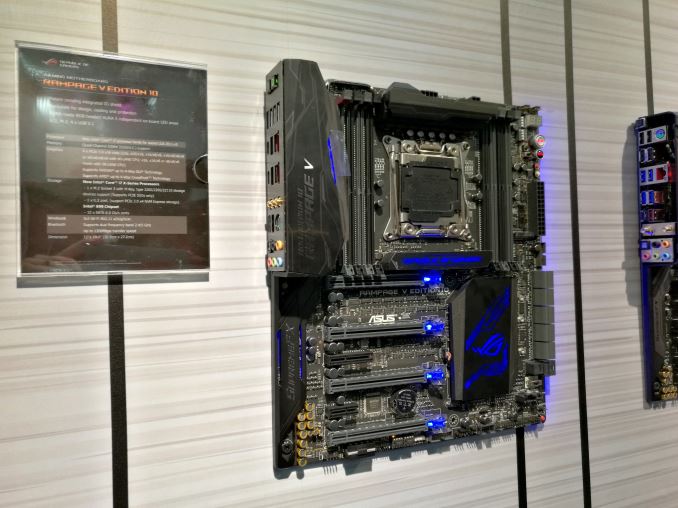
Click the image for the full resolution
The most obvious change to the Rampage V Edition 10 is the PCIe slots. Instead of lighting up an LED beside the PCIe slot that needs the graphics card, ASUS has moved to a semi-transparent PCIe latch with an LED underneath that uses a microcontroller for various lighting effects. There are going to be a number of motherboards with this coming in the near future, but the blue lighting here is for the Edition 10.
Compared to the original RVE, the black design is reminiscent of the Rampage IV Black Edition, but there are also a few more updates. ASUS removed the SATA Express ports in the SATA area, and replaced them with a U.2 port that supports PCIe 3.0 x4 drives, like Intel’s SSD 750. The rear panel protector, designed to enhance the aesthetic, is now placed down the side of the motherboard covering most of the audio pathways, although a few filter caps are moved to outside the guard.
Also on the list is the middle PCIe 3.0 x4 slot, which on the original RVE was a full length PCIe 3.0 x4 slot, but here is reduced to an open ended PCIe 3.0 x4 slot. I suspect there will be a few more changes, particularly with Broadwell-E, such as the addition of a second 4-pin DIP switch system on the top right of the board, however if we get the board in to test we’ll go in deeper.
The Rampage V Edition 10 is already on sale, coming in at $600.
ASUS Strix X99 Gaming
The Strix brand at ASUS is having an interesting time. It was originally released on certain graphics cards to signify silent operation, and use the eagle eyes logo to come across as ‘silent but deadly’. Since then, the Strix name has been moved from low-noise to a general ‘value’ proposition model line, pitching behind some of the more well-known ASUS brands. In this case, Strix is meant to signify a fully featured but slightly different to ROG gaming brand with a lot of features but not necessarily ROG branded. I would assume that means that Strix gets a different software package, which might reduce the cost over ROG.
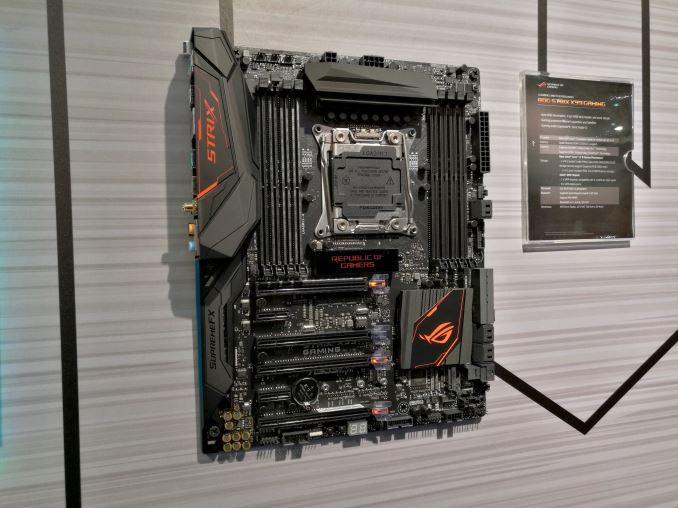
Click the image for the full resolution
The Strix board as shown above looks like a hefty X99 motherboard, using a full array of DIMMs, support for three proper graphics cards, a rear IO/audio combination plate, both SATA Express and U.2 support and multiple fan headers. If only faintly, you can also tell that this model also has the transparent PCIe slot latches similar to the Edition 10, this time in a red/orange color.
The Strix is aimed at 2/3-way high-end desktop systems, and will offer full ‘Aura’ RGB illumination with a separate RGB strip header for a bundled RGB strip to be used with software. It will have a few gaming tools similar to ROG, including Sonic Radar II. The Strix X99 Gaming current retails for around $340.
When you’ve been reviewing and testing motherboards, as well as shouting at certain engineers for absolutely nonsense ideas (or really good ones), there is somewhat a monotony to it all. One generation there’s a new feature from one manufacturer, and the next generation we see it on mostly all the others. Some features are special and aren’t copied, but these require larger amounts of R&D and investment, then require the PR teams to communicate why the new feature is good or not.
One interesting conversation I had a couple of years ago was regarding the future of motherboard form factors. It was then as we see now: the full sized ATX, micro-ATX and mini-ITX systems accounted for 99%+ of desktop class PCs. Some large OEMs had their own designs on desktops, Zotac has a number of small mini-PCs for various markets, and servers do all sorts of standard and non-standard sizes, but for consumer, it is essentially all about those three (and mini-STX is now moving in to that space). So a couple of years ago, when the initial talk of Steam machines was coming in to play, ASUS asked me what I thought about non-standard motherboard sizes in desktop sized systems.
It should be clear to most that the motherboard size issue is a chicken/egg situation. When Intel designs a CPU, there are certain limitations to where everything should go. Or no, I will correct that – there’s a budget limitation to where things can go. For example, memory is often to a certain side of the CPU because that provides the best quality signal for the onboard traces. Technically it can go on a different side (as it does on some designs), but that often requires more motherboard PCB layers to ensure the signal does not degrade or interfere with other signals, and in most cases there is a performance/latency penalty if you have to put it further away. But in order to stay buoyant, a motherboard manufacturer will stick to the appropriate design, because guess what – all the cases use the same standards too. The minute you produce a novel motherboard design, such as a different IO position or a new method for storage, none of the current cases on the market will work with it. So the case manufacturers can’t change because there are no products in a new design, the motherboard manufacturers can’t change because of the lack of cases but also the cost, and Intel keeps it consistent to keep everyone in the chain happy. Hello chicken, meet egg. Hello egg, meet chicken.
The only way to do a custom form factor is to build the system completely yourself, which is what Zotac does. Zotac plays mainly in the mini-PC market, and their owner Partner (‘Manufacturer of motherboards, AGP cards and other consumer electronics’ on their Google Search) has long fingers into manufacturing for other big name brands, so integrating the Zotac brand into new designs with custom chassis is easy enough. However ASUS wanted to go bigger and better, and that is how systems like the G20, a full desktop with a custom design, and the GR8, a book-sized Steam machine, came about. But it was clear, ASUS wanted more. Insert Project Avalon.
Project Avalon
Project Avalon is a custom, high-performance, gaming/VR PC design from ASUS. It is still very early in the design cycle, to the extent that this chassis currently weighs almost 40 lbs, but the concept is there. Inside is a custom designed motherboard that uses various internal connectors to implement various features. The design as it stands is built for Skylake plus a single GPU, and enough space to operate liquid cooling. The Perspex window on the top is so users can see in to the design, flashing lights and all.
Astute readers will note that the PCB design looks rather odd – there isn’t a PCIe slot here, no power delivery, no rear IO, and what looks like the rear of a 24-pin power connector on the left-hand side. All we needed to do was take the motherboard out:
On the top we have a CPU socket, some memory slots, an M.2 slot, and what looks like a number of connectors for daughter boards. If we flip it over:
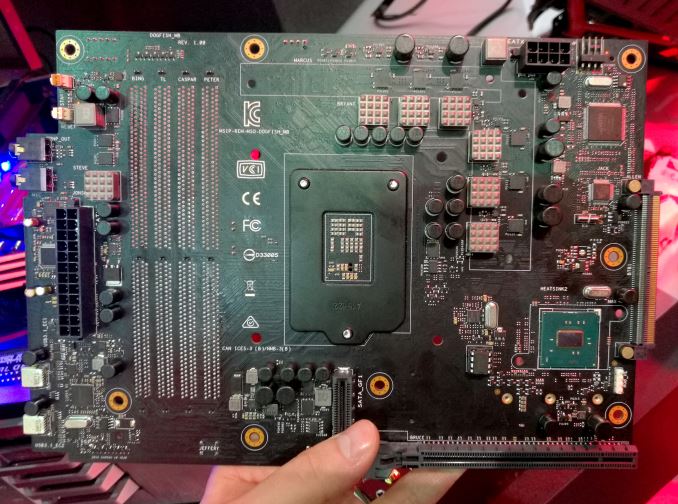
Click the image for the full resolution
Here we see more of what we know – power delivery chokes, a chipset, an 8-pin CPU power connector, a PCIe x16 connector and a 24-pin power connector. There are no SATA ports, and nothing on this system looks normal.
So, to explain: on the bottom near my finger is a custom connector, akin to a 4x PCIe connector, that breaks out into four SATA ports on a daughter board where are hot swappable on the chassis. The connector supplies both data and power. On the far right is a proprietary ASUS header for the rear IO.
At current, ASUS is not finalized on the pin layout and isn’t conforming to any particular standard, but this connector can send chipset PCIe lanes, digital video, and a few other things, over to a daughter board. This means one thing – adjustable rear IO panels!
I love this idea. Here are two examples of what ASUS suggests: the top one is a rear IO for workstation users, featuring dual Intel NIC and inside is a RAID capable M.2 slot running at PCIe 3.0 x4. The rear panel is a Home Theater focused design, using a single NIC and a USB 3.1 controller for 10 Gbps use. ASUS also had a VR edition with the specific ports required for the big VR headsets currently in the market. Because the custom connector carries enough PCIe, this opens it up to other custom designs, such as Thunderbolt, 10 Gbit Ethernet, different Ethernet/WiFi, additional storage, or anything that needs PCIe. Also, on the audio side, because this is a separate board, it could also influence audio capabilities and provide cleaner signals for audio processing. Adjustable rear IO is a topic only just being breached, with plenty of possibility.
Avalon's design is still very much fluid, with one GPU currently being supported:
I won’t go too much into Avalon here, as we were able to get some hands-on time with Jonathan Tseng, the product manager of Avalon, and do a quick teardown video after the show had finished. The audio on the video needs some cleaning up, and we’ll try and post that in due course. In the meantime, here’s a quick teardown video of the motherboard:
The video is silent
At this point the Avalon project is in an early design phase, so ASUS is looking for feedback with what they have so far. I don’t particularly mind if this ends up being an engineering concept design that never goes on sale (I’ve been pushing manufacturers to do more concept designs, similar to vehicle manufacturers at car shows), but the fact that ASUS are prepared to even attempt this is a good thing.
Desktops: ROG G31
Moving from something completely custom in the Avalon to something we’ve seen before, but upgraded. The new G31 Edition 10 is an upgraded version of the G20, a gaming desktop PC that ASUS announced last year under their Mayan-style design strategy that also included the small book-sized GR8 desktop. The G20 aimed at the crowd that wanted a different style of desktop/gaming machine, with a different look but everything pretty much integrated in a design that aimed to adjust the airflow for such a large amount of power. The G31 by comparison doubles up the number of GPUs and equips the system with the latest processors and memory.
The Edition 10 version of the G31, designed for the ROG 10-Year, will be the fully upgraded model with a 10-Year sticker on the side. This edition will house a full Core i7 (most likely the i7-6700/K), two full GTX 1080s in SLI, the Z170 chipset, support for four DDR4 memory modules and 64 GB (it’s not mentioned if they are SO-DIMM or regular), and at least two M.2 PCIe 3.0 x4 slots capable of RAID-0. To top it off, the optical disk drive at the front is also a Blu-Ray writer/DVD writer as well.
For the Edition 10, all the LEDs are RGB and additional LEDs are placed down the side stripe as well.
Being under the red lights on the show made it a bit difficult to see the LEDs, but the full chassis comes in at a 20L volume. If we compare that to the recent review of the NZKT Manta mini-ITX case from Tracy which comes in at 47L, we can see the benefits of going custom in something like this – the full motherboard and GPUs are custom for the design and are arranged to use the cooling system as efficient as possible.
Typically a PC chassis has the power supply bundled inside, however to fit this shape and design ASUS are going with an external power supply. We weren’t given an exact rating, but if we give a generous budget of 100W for the CPU, 200W each for the GPUs, 100W for everything else and then an extra 20%, then it’s probably around 720W.
No words as to pricing or release dates as of yet, but the high end ROG G20 with an i7-4790, 16GB of DRAM, a single GTX 745 and a 1TB SSD is currently retailing on Amazon for $1360. I would expect the high edition ROG G31, with dual GTX 1080 GPUs and 64GB of memory, to be nearer $4000. Of course, something like the MSI Vortex (which uses mobile GPU variants of GTX 960/970) is the competition here, and the high end version of that is $4000 as well.
The battle between ASUS and MSI for the best gaming ‘laptop’ is blurring some very thick lines. Both vendors now look at laptop water cooling as the top option, which drags the ‘laptop’ side of the equation heavily into a portable desktop scenario, depending on how heavy you think a portable system should be. At this point one might realize that the main difference between one of these systems and actually moving a desktop system is having to move a monitor, however I am told that high-end gaming notebooks, despite the investment, have a reasonable return and offer a flagship product at the top of the gaming notebook stack. At Computex we saw the next iteration of ASUS’s design, the GX800.
The ASUS ROG GX800: A Dual-GPU Liquid Cooled Laptop
On the last page we saw a 20L desktop design with dual GTX 1080s. The GX800 by comparison takes the higher efficiency GTX 980 MXM modules designed for laptops into the cooling loop, along with a Skylake based Core i7.
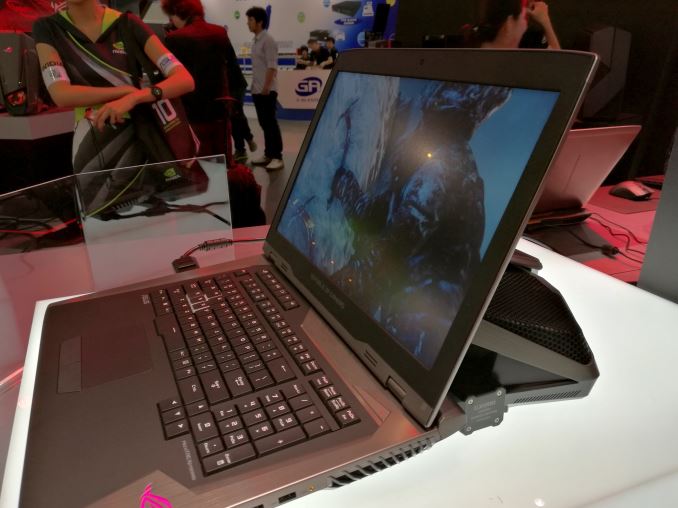
Click the image for the full resolution
The GX800 will come with a mechanical keyboard, offering 2.2mm of key travel, under the ‘MechTAG’ name. ASUS says they are using a custom type of switch, one they’re not willing to divulge at this time, but it should be akin to brown/red switches. It’s worth noting that by comparison to the main competition, ASUS has the keyboard in ‘the usual’ place for a notebook, whereas MSI has it at the bottom of the design as most gaming environments would necessitate a separate mouse.
On the sides we see a Thunderbolt 3 port, a USB 3.1 Type-C port (10 Gbps, and with TB3 indicates they are using the Intel Alpine Ridge controller), a USB 3.0 Type-A, separate mini-DisplayPort and HDMI ports, and a full-sized Ethernet port. There’s also an antenna segment, for users to have an external WiFi antenna, however it is worth noting that this in on the right-hand side of the system, which might cause a wire to interfere with anyone using a mouse on the right-hand side.
Obviously a system using dual GTX 980 graphics with a Core i7, even a 45W one, and a 4K display is going to be drawing some power. To that extent, ASUS uses two power supplies for the system. In order to use the discrete graphics, the power cable on the left in the image above needs to be in place as the system starts up. The system is designed to be overclocked, and if I recall correctly both power supplies should be around the 300-330W variety, allowing for a 600-660W system.
ASUS has not been discussing the GX800 that much in terms of exact specifications as of yet, though I would expect it to hit shelves in the second half of the year.
External Graphics: The XG Station 2
Back at CES in January we saw a number of external graphics solutions from ASUS, Razer and AMD. The latter two were using AMD’s solution over a Thunderbolt 3 PCIe based connection in a surprise collaboration between AMD and Intel, and the goal was to handle things like graphics hot-plug over TB3 appropriately. ASUS’ solution was to use a proprietary signal over TB3 to their XG Station, which would limit its usefulness to approved GPUs and approved ASUS laptops. For Computex, ASUS has dropped their custom solution and going with the recommended external graphics solution via Intel/AMD.
The XG Station 2 itself gets a design upgrade for the ROG 10-Year, featuring the Mayan design similar to the other ROG desktop products. The Station itself looks a little bit larger than before as well, with ASUS intent on physically supporting as many single GPU graphics cards as possible.
In opening it up, it is worth noting that the cooling methodology for this revolves around the three small fans at the top of the XG Station 2, drawing air in through the top and forcing it through the GPU. The exhaust then comes out the rear. Despite all the GPU action being on the left hand side of the device, the right hand side has some electronics so the dock can also be used for expansion ports.
In this case we have a USB 3.1 hub to allow for more ports, another network port (an Intel NIC), and additional Thunderbolt 3 connectors for other storage devices. It is worth noting that all the data goes through the single cable back to the main PC, and I’m unsure at this point which elements of the design have data priority (PCIe, networking, USB, or Display).
I wanted to touch on some of the non-ROG hardware in the ASUS Booth, some of which we haven’t seen before. First up is the TUF range, which ASUS uses as their hardware wearing, more physically demanding and higher warrantied product line. Typically we see one or two TUF motherboards each generation, with the Sabertooth variant in a camouflage design and the Mark S in white camo. At this point the Mark S doesn’t have the TUF branding, but it takes a lot of the aesthetic design – we reviewed the genesis model #0001 off the production line back in November 2014.
990FX Sabertooth R3.0
Despite AMD’s 990FX platform being nearly five years old, the FX processor line still represents AMD’s high performing processor lineup for consumers. Due to the age, most motherboard manufacturers issue the odd update now and again to refresh the line with some of the latest technologies. The 990FX Sabertooth has had two versions already, and at Computex we saw R3.0 with RGB LEDs, reinforced PCIe slots, M.2 integration, USB 3.1 Type-C, semi-transparent PCIe latches and a new variant of ASUS’ Q-LED.
Being part of the TUF family means that ASUS tends to over-engineer the board to cope is harsher environments. This means upgraded power delivery, combination heatsinks and that reinforced PCIe slot, but it also gets visual enhancements such as the color scheme and rear IO cover to maintain the look.
The rear panel comes with four USB 3.0 ports from the chipset as well as four USB 3.1 ports. These are from ASMedia ASM1142 controllers, with one for each pair of ports. One of these is USB Type-C, supporting the reversible USB connection standard now being seen on some smartphones.
One of the interesting things for me, however, was the adjustment of the Q-LEDs. ASUS’ system uses a series of LEDs that light up as the system turns on and configures itself for the hardware inside. As the hardware may have changed since the startup, or the quality of the hardware has changed over time, the system needs to ‘retrain’ its pathways to make sure it can support the data rates the BIOS tells it to. As the system checks different parts of itself in POST, the LEDs relating to CPU, DRAM, VGA, Booting and PWR light up in turn. If there is an issue, the LED that stays lit should show you which part has an issue.
Now normally the Q-LED layout was a small segment on the top right of the board, with some onboard text saying which LED did what. It would seem that for the R3.0, the Q-LEDs have made it on the chipset heatsink. I think this is a great idea, as it allows for a bigger font size and arguably more powerful/configurable LEDs next to a microcontroller. Ultimately I think the Q-LEDs should be nearer the bottom, just in-case a large GPU comes along and blocks the view.
Whether you think this is useful for a 990FX board in mid-2016 is up to you. ASUS seems to think so.
TUF Detective
Attached to the Z170 TUF motherboard was a tablet running the TUF Detective application. The idea here is that a user can see fan/temperature/voltage values on the fly, or control the system via the app. At present the tablet has to be connected to the motherboard, and we have seen something similar to this on ASUS Extreme motherboards and overclocking, however from the monitoring point of view this is an interesting angle. If ASUS combined this with a self-contained IPMI control chip similar to servers, and a WiFi/Bluetooth module that was separate, perhaps a user could control their system via WiFi rather than USB.
Anyone remember when 32-inch 4K monitors were $3500? We reviewed ASUS’ PQ321Q back in July 2013, and since then every monitor manufacturer under the sun has some 4K variant, or in some cases, a wide variety of high-performance, high-quality panels broaching professional status and all at a seemingly cheaper price than what we saw only three years ago. Case in point, my three Dell UP2415Q monitors I purchased in 2015 were under $500 each (it was either that or buy a DSLR; the monitors won). But now that 4K is slowly moving down the chain into the mainstream, even with ultra-wide 21:9 monitors in tow for gaming, the next barrier is 5K.
5K monitors, using a 5120x2880 resolution, comes in at twice the 2560x1440 (colloquially ‘25x16’) panels we saw flood the market around the same time that 4K was starting to take hold. Of course, pushing 3.7 million pixels on a 25x16 panel back then was tough, but now going for almost 15 million pixels on the new 5K standard is somewhat insane. Luckily 14nm/16nm GPUs are being released this year…!
Apple’s 5K iMac has been the first serious attempt at a 5K display, attaching a custom TCON arrangement to a 27-inch panel. The minimum price for this is $1800, but that includes the rest of the iMac: a quad-core Intel Core i5 processor with Iris Pro graphics, 8GB of memory, a 1TB mechanical drive, and an AMD R9 M380 high-end mobile graphics card. Dell’s 5K panel, the UP2715K, can be used on any monitor with dual DisplayPort in MST mode. Luckily MST modes are more mature than when they first appeared on 4K, and from what is online, the 5K MST mode is more manageable than it was back in 2013.
The ASUS ProArt
So enter ASUS into the 5K market, with the ASUS 32-inch 5K ProArt display.
The ProArt name and lack of an official SKU number suggests both that ASUS is aiming for the professional market first and that the device is still being finalized.
With the display, ASUS is quoting 100% Rec.709, 99.5% AdobeRGB and 95% DCI-P3 in terms of color reproduction, as well as bundling the display with ASUS’ ProArt calibration tools. The display will support DisplayPort 1.3, which suggests that only a single cable should be needed to run at 60Hz when using 24-bit color. Given that this is a professional display, I would assume that increasing the color bit-depth to 10-bit would require a reduction in refresh rate to compensate.
Connectivity on the rear includes HDMI 2.0, DisplayPort 1.3, five USB 3.0 ports (a hub) and a 9-in-1 card reader.
DisplayPort over Type-C: The ASUS 4K Designo MX27UC
The march towards Type-C acceptance is strong, and one of the poignant benefits of Type-C is meant to be that in the right circumstances, it will support video. We’ve seen Apple’s Thunderbolt display do something similar in the past using Thunderbolt, but in this case the new ASUS Designo MX27UC uses the USB 3.1 Type-C port with power delivery, DisplayPort alternate mode and data transmission modes.
Rather than a professional display, ASUS is butting this into a premium look product. The MX27UC will have a 3840x2160 (‘4K’/UHD) resolution, a brushed metal ‘frameless’ design and Bang&Olufsen speaker technology. It is worth noting that while frameless, it isn’t actually borderless, with a good 5-7mm around the display being required around the edges.
The three major form factors for custom build personal computers, in order of popularity, are ATX, followed by micro-ATX and then mini-ITX. That also happens to be the order of size as well, from largest to smallest. Earlier in this piece we spoke about how motherboard design has not really changed from these three as of late, mostly due to compatibility and how everything in the industry currently works. However, at IDF in 2015, Intel announced a new form factor for mini-PCs relying purely on integrated graphics: the Mini-STX platform (also known as 5x5, for 5-inch square).
5x5
Before I left for Computex, I asked our editors want they knew would be at the show and what they would like me to cover. One of the responses from Ganesh was ‘anything Mini-STX’. We saw a couple of things at CES, although mostly pre-built mSTX systems. Luckily for Ganesh, ASUS had three motherboards on display.
The first up is the Q170S1, using the Q-series chipset for business level customers and vPro support. We haven’t typically covered the Q-series at AnandTech, however the Q170 attempts to mirror a lot of what the Z170 does but under the provision of a professional grade, managed system that doesn’t go into Xeon. This includes business level support, a separate firmware with control options, and a number of other things. There is an extra cost to the Q-series over the H-series chipsets, around $12 list price, but for the business side benefits this is usually a small price for manageability. In this case, the Q170S1 can use any Skylake processor up to 65W (up to i7-6700), two DDR4 SO-SIMM modules, and supports M.2, SATA, M.2 for WiFi, and rear panel 19V power. All graphics capabilities come from the CPU, and there’s also a vPro enabled network port to facilitate network control.
On the cheaper side of the coin are the H-series variants. These are strikingly similar in board layout, with the S2 version having dual network ports (one Intel I219-V and one Realtek 8111H) whereas the S1 version only has a single Intel I219-V. Specifications match up to the Q170S1 motherboard otherwise, with 65W processor support, but nothing vPro related.
Mini-STX is a drive for Intel towards the more industrial side of the market that wants upgradability. There are a number of platforms already in that space, such as the Intel NUC, Core-M, Atom, ECS LIVA, the MSI Cubi and others, however they are all using soldered down processors. Mini-STX enables a bit more customization within Intel’s platform structure, as well as more performance.
Pimp My Rig
As with other big booth tour articles from previous shows, I want to end on a ‘we saw a lot of this’ series of images. Now two things were very clear at Computex regarding PC hardware: first was RGB LEDs, and the second was modified system designs. The march on RGB LEDs for almost everything in the consumer space makes a number of long-term PC enthusiasts put their head in their hands, but the case modification aspect is rather interesting. For each show, manufacturers will commission PC designs from external contractors to create something unique in terms of looks that can be shown on display. Whether or not you think the case modding scene is a reasonable market, for a number of enthusiasts this is now their full-time job – making custom designs. ASUS had several on display, from both professional modders and system integrators looking to do something new.
We mentioned the 8Pack system on the first page, and this system had a major stand all to itself at the show. Inside are custom water blocks featuring the 8Pack logo, and three graphics cards being liquid cooled. Ian Parry’s goal (aka 8Pack), and that of OverclockersUK, is to build and offer for sale the highest overclocked pre-built systems that money can buy, sometimes north of $15000 or even more when combined with premium accessories. Ian and I have known each other on the overclocking scene for a number of years, and I totally believe him when he says they are selling all over the world, and selling well. For some high earners where time is money, but money is no object, these get purchased for family members or high profile clients. It’s an interesting world out there.
On the TUF side of the booth were these two systems, part of the TUF Duplex design by Alexander Hede. Essentially two halves of the TUF logo and in a yin/yang style, one side uses the Z170 Sabertooth Mark 1 and the other has the Z170 Sabertooth.
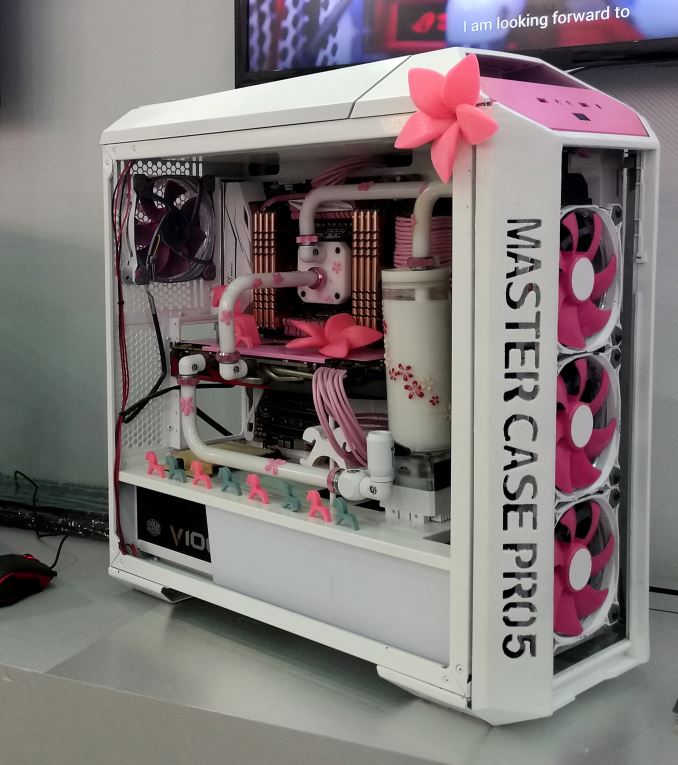
Click the image for the full resolution
Or perhaps a liquid cooled Hello Kitty design, in a Cooler Master Mastercase Pro 5, is more your thing.
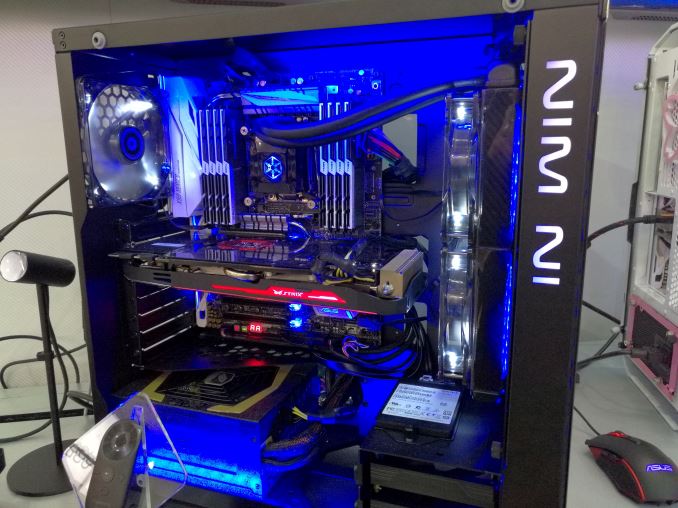
Click the image for the full resolution
This isn’t necessarily a crazy mod, but it is worth noting what can be done with a few simple LED fans and strip lighting. We showcased the white G.Skill Trident Z in our Broadwell-E review, and it comes up here as well. The motherboard uses semi-transparent PCIe latches in a new X99 motherboard, and the STRIX graphics card lights up as well.
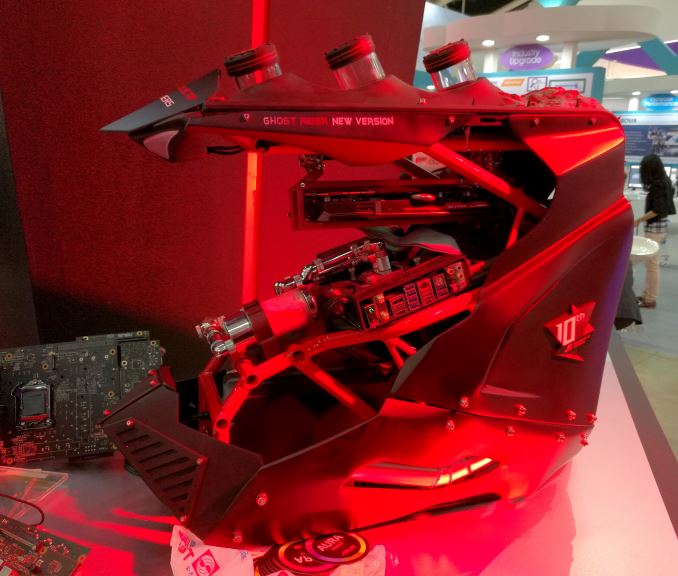
Click the image for the full resolution
Bathed in the red light of ROG was this, the Ghost Rider (new version). So there are two types of mods: ones that directly affect performance, like liquid cooling designs, and others that are purely for aesthetics. This mostly falls into the latter, with a Maximus VIII Impact mini-ITX motherboard but a graphics card connected above it using a PCIe ribbon cable. As the plate on the side suggests, this design was done specifically for the ROG 10-Year Anniversary.
Aside from all the one-off custom designs, ASUS’ system integrator partners were also at the show with a few of their more popular models. This is the DigitalStorm Velox, playing off the black and red Strix/eagle design but using as much ASUS as possible. The system here is the premium design: an ROG Rampage V Edition 10, three ASUS Strix GTX 980s, a Core i7-6950X with custom liquid cooling, the ROG MG248Q Gaming monitor (24-inch, 1080p, 144 Hz), ROG Gladius mouse, Strix Tactic Pro keyboard, Strix 7.1 headset, and even an ROG Whetstone mouse pad. Obviously for the ultimate ROG fan.
Origin had a custom case for their recently launched Millennium product line, again going with a lot of ASUS and as much horsepower under the hood.
Scan from the UK and Lynx were also at the show using more modest designs in In Win cases.

